Analysis of Integrated Marketing Communications
VerifiedAdded on 2021/04/21
|26
|6211
|114
AI Summary
The provided document is an analysis of integrated marketing communications (IMC) in different fields, focusing on hotel websites, online marketing tools, and the impact of IMC on customer behavior and brand equity. It includes a list of references from various articles and books related to IMC and its applications in hospitality management. The analysis provides insights into how IMC can be used effectively in hotel companies and its influence on customer-based brand equity.
Contribute Materials
Your contribution can guide someone’s learning journey. Share your
documents today.
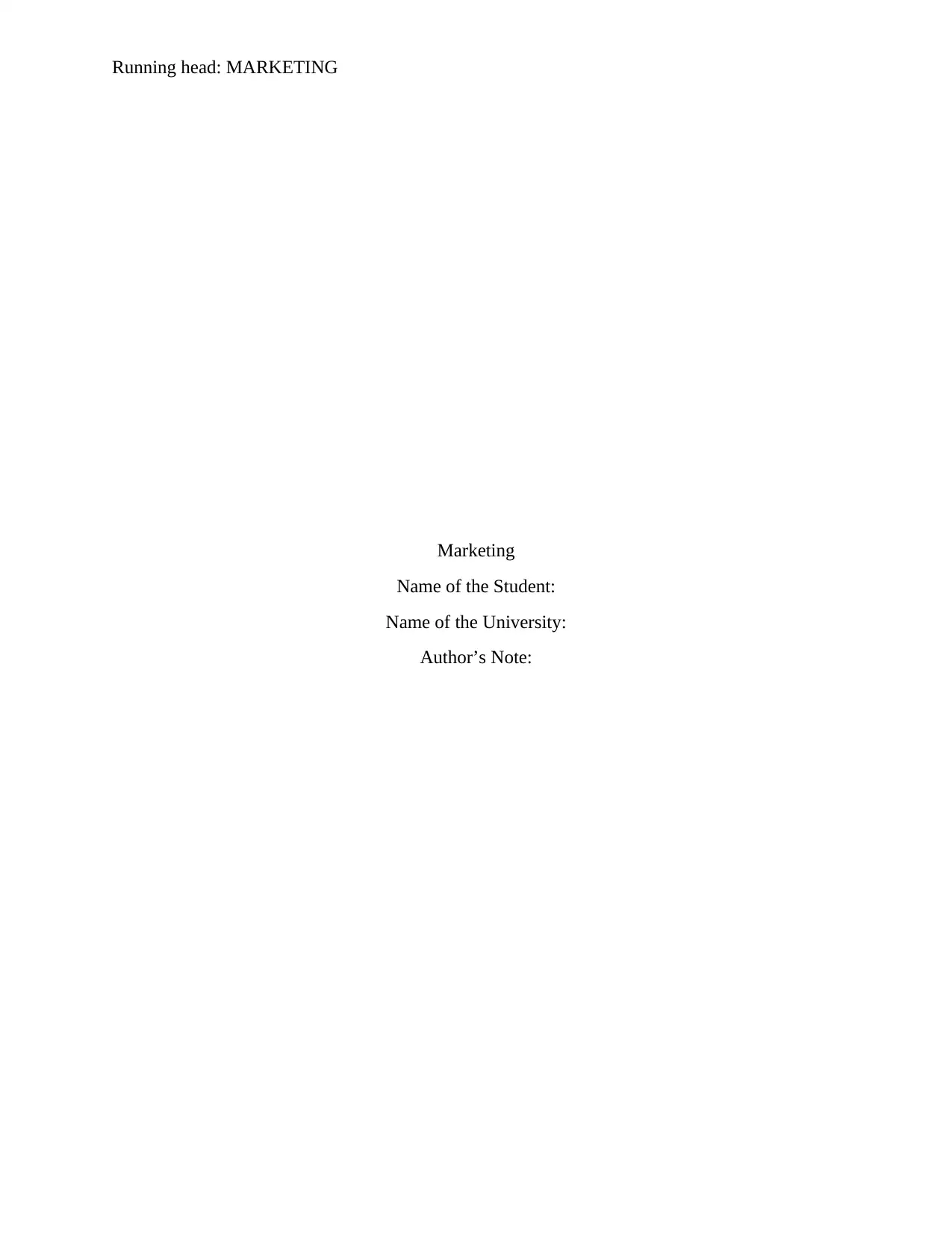
Running head: MARKETING
Marketing
Name of the Student:
Name of the University:
Author’s Note:
Marketing
Name of the Student:
Name of the University:
Author’s Note:
Secure Best Marks with AI Grader
Need help grading? Try our AI Grader for instant feedback on your assignments.
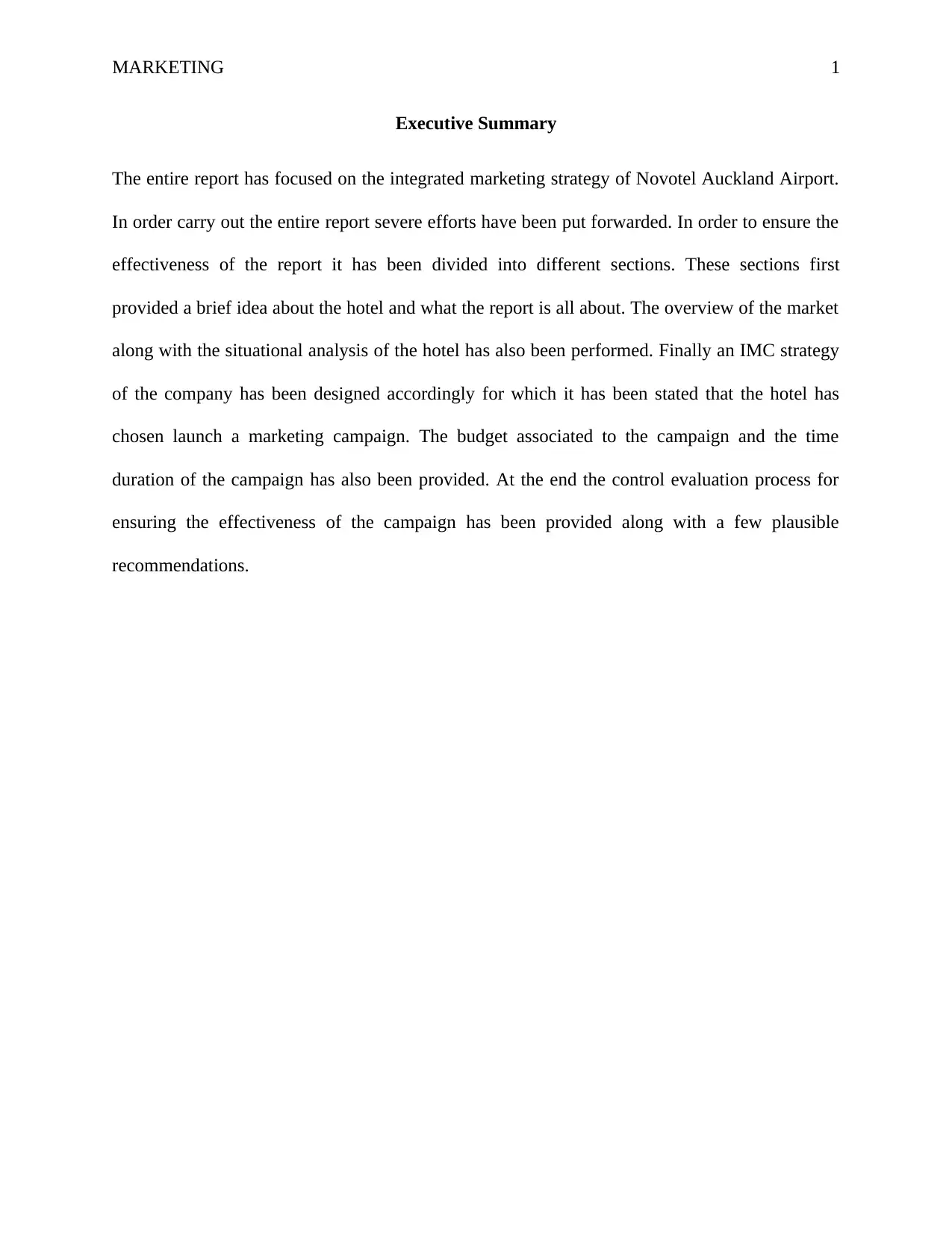
MARKETING 1
Executive Summary
The entire report has focused on the integrated marketing strategy of Novotel Auckland Airport.
In order carry out the entire report severe efforts have been put forwarded. In order to ensure the
effectiveness of the report it has been divided into different sections. These sections first
provided a brief idea about the hotel and what the report is all about. The overview of the market
along with the situational analysis of the hotel has also been performed. Finally an IMC strategy
of the company has been designed accordingly for which it has been stated that the hotel has
chosen launch a marketing campaign. The budget associated to the campaign and the time
duration of the campaign has also been provided. At the end the control evaluation process for
ensuring the effectiveness of the campaign has been provided along with a few plausible
recommendations.
Executive Summary
The entire report has focused on the integrated marketing strategy of Novotel Auckland Airport.
In order carry out the entire report severe efforts have been put forwarded. In order to ensure the
effectiveness of the report it has been divided into different sections. These sections first
provided a brief idea about the hotel and what the report is all about. The overview of the market
along with the situational analysis of the hotel has also been performed. Finally an IMC strategy
of the company has been designed accordingly for which it has been stated that the hotel has
chosen launch a marketing campaign. The budget associated to the campaign and the time
duration of the campaign has also been provided. At the end the control evaluation process for
ensuring the effectiveness of the campaign has been provided along with a few plausible
recommendations.
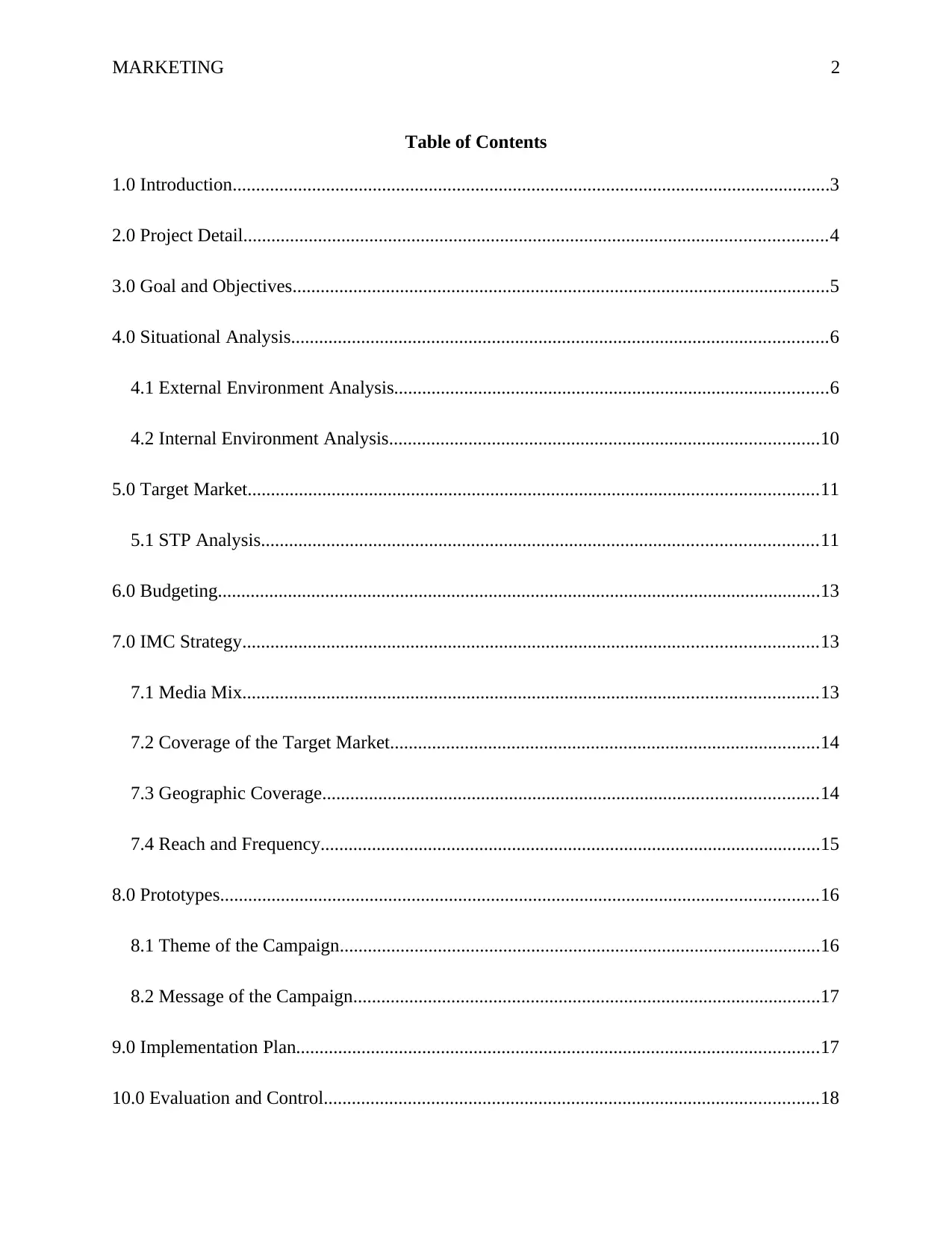
MARKETING 2
Table of Contents
1.0 Introduction................................................................................................................................3
2.0 Project Detail.............................................................................................................................4
3.0 Goal and Objectives...................................................................................................................5
4.0 Situational Analysis...................................................................................................................6
4.1 External Environment Analysis.............................................................................................6
4.2 Internal Environment Analysis............................................................................................10
5.0 Target Market..........................................................................................................................11
5.1 STP Analysis.......................................................................................................................11
6.0 Budgeting.................................................................................................................................13
7.0 IMC Strategy...........................................................................................................................13
7.1 Media Mix...........................................................................................................................13
7.2 Coverage of the Target Market............................................................................................14
7.3 Geographic Coverage..........................................................................................................14
7.4 Reach and Frequency...........................................................................................................15
8.0 Prototypes................................................................................................................................16
8.1 Theme of the Campaign.......................................................................................................16
8.2 Message of the Campaign....................................................................................................17
9.0 Implementation Plan................................................................................................................17
10.0 Evaluation and Control..........................................................................................................18
Table of Contents
1.0 Introduction................................................................................................................................3
2.0 Project Detail.............................................................................................................................4
3.0 Goal and Objectives...................................................................................................................5
4.0 Situational Analysis...................................................................................................................6
4.1 External Environment Analysis.............................................................................................6
4.2 Internal Environment Analysis............................................................................................10
5.0 Target Market..........................................................................................................................11
5.1 STP Analysis.......................................................................................................................11
6.0 Budgeting.................................................................................................................................13
7.0 IMC Strategy...........................................................................................................................13
7.1 Media Mix...........................................................................................................................13
7.2 Coverage of the Target Market............................................................................................14
7.3 Geographic Coverage..........................................................................................................14
7.4 Reach and Frequency...........................................................................................................15
8.0 Prototypes................................................................................................................................16
8.1 Theme of the Campaign.......................................................................................................16
8.2 Message of the Campaign....................................................................................................17
9.0 Implementation Plan................................................................................................................17
10.0 Evaluation and Control..........................................................................................................18
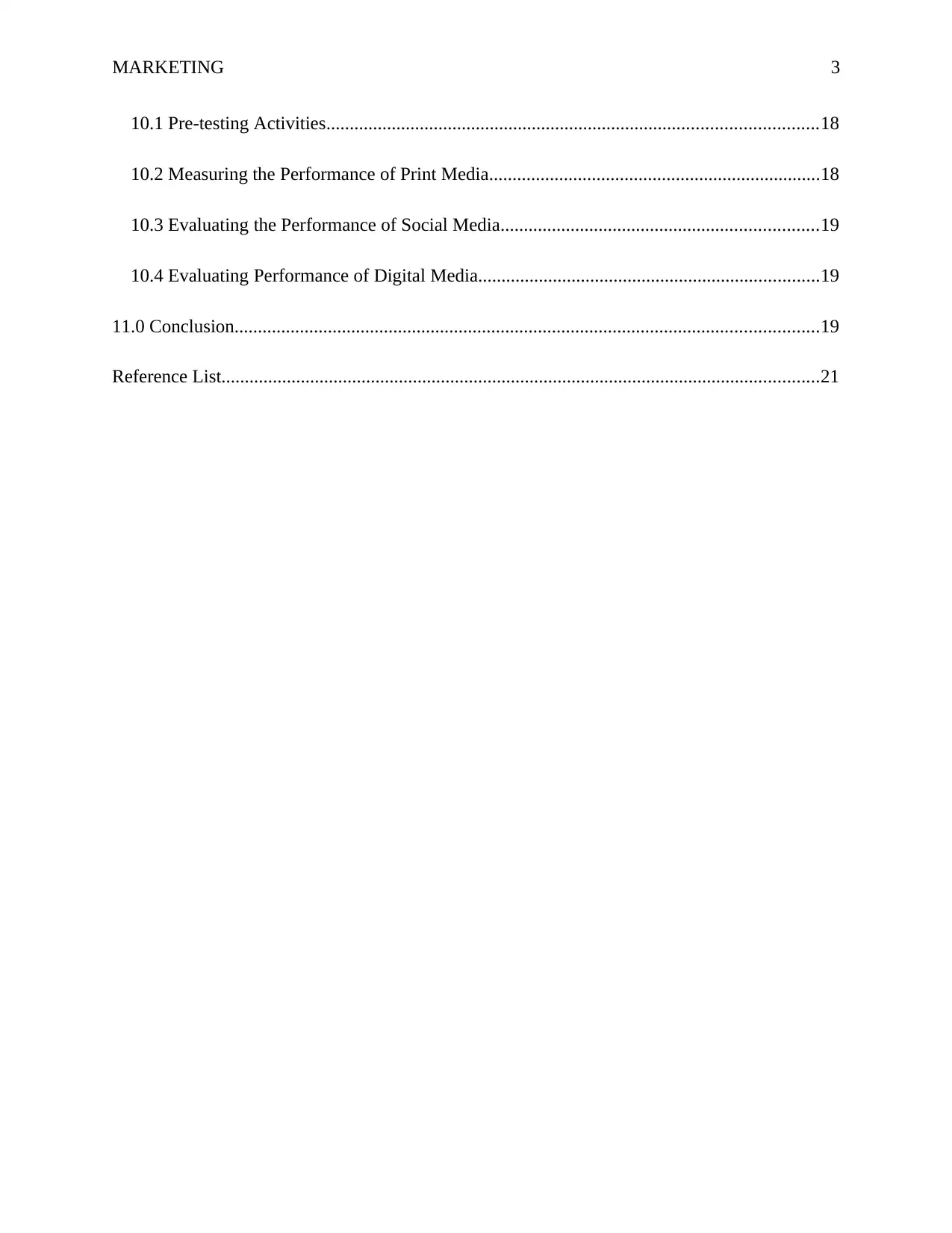
MARKETING 3
10.1 Pre-testing Activities.........................................................................................................18
10.2 Measuring the Performance of Print Media.......................................................................18
10.3 Evaluating the Performance of Social Media....................................................................19
10.4 Evaluating Performance of Digital Media.........................................................................19
11.0 Conclusion.............................................................................................................................19
Reference List................................................................................................................................21
10.1 Pre-testing Activities.........................................................................................................18
10.2 Measuring the Performance of Print Media.......................................................................18
10.3 Evaluating the Performance of Social Media....................................................................19
10.4 Evaluating Performance of Digital Media.........................................................................19
11.0 Conclusion.............................................................................................................................19
Reference List................................................................................................................................21
Secure Best Marks with AI Grader
Need help grading? Try our AI Grader for instant feedback on your assignments.
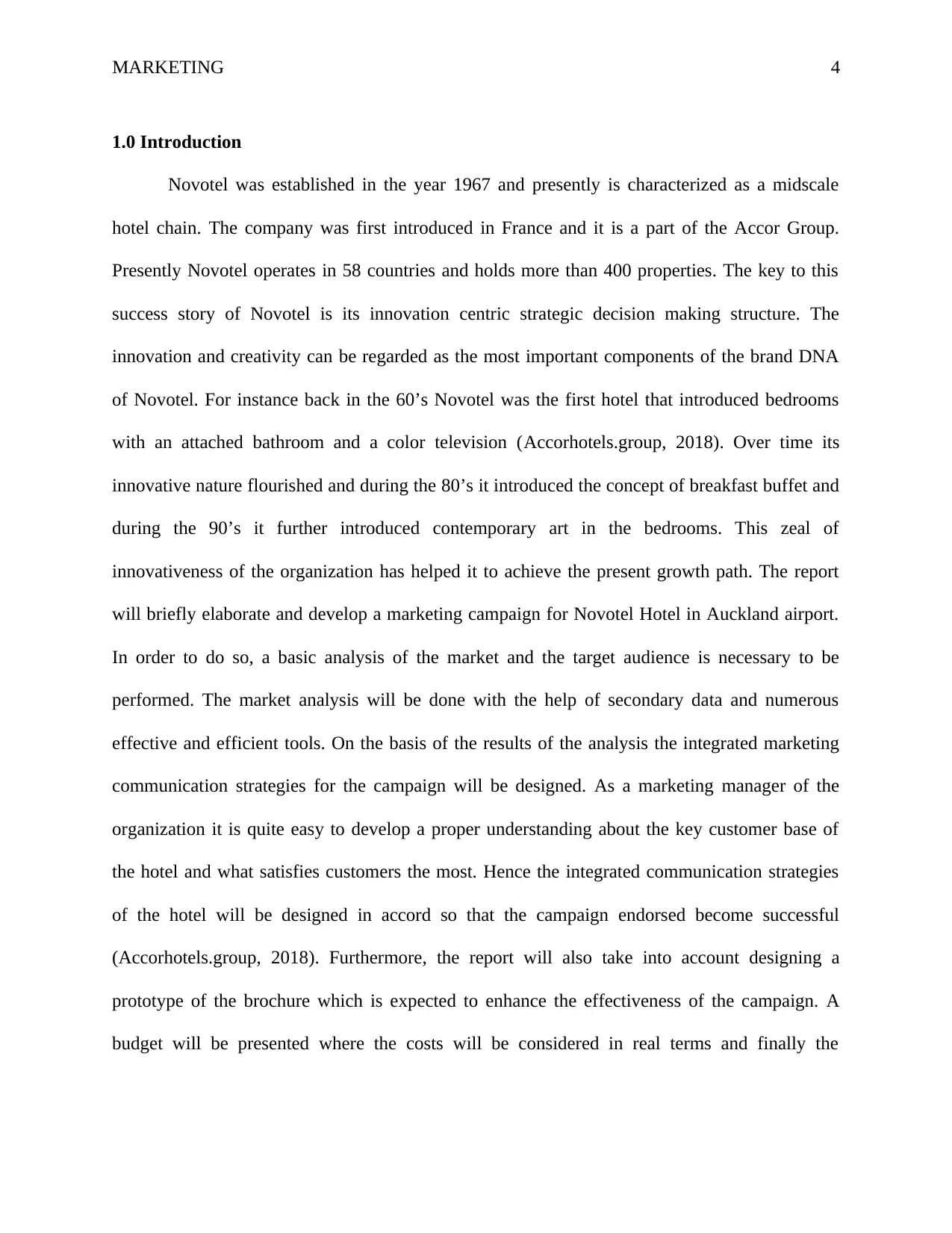
MARKETING 4
1.0 Introduction
Novotel was established in the year 1967 and presently is characterized as a midscale
hotel chain. The company was first introduced in France and it is a part of the Accor Group.
Presently Novotel operates in 58 countries and holds more than 400 properties. The key to this
success story of Novotel is its innovation centric strategic decision making structure. The
innovation and creativity can be regarded as the most important components of the brand DNA
of Novotel. For instance back in the 60’s Novotel was the first hotel that introduced bedrooms
with an attached bathroom and a color television (Accorhotels.group, 2018). Over time its
innovative nature flourished and during the 80’s it introduced the concept of breakfast buffet and
during the 90’s it further introduced contemporary art in the bedrooms. This zeal of
innovativeness of the organization has helped it to achieve the present growth path. The report
will briefly elaborate and develop a marketing campaign for Novotel Hotel in Auckland airport.
In order to do so, a basic analysis of the market and the target audience is necessary to be
performed. The market analysis will be done with the help of secondary data and numerous
effective and efficient tools. On the basis of the results of the analysis the integrated marketing
communication strategies for the campaign will be designed. As a marketing manager of the
organization it is quite easy to develop a proper understanding about the key customer base of
the hotel and what satisfies customers the most. Hence the integrated communication strategies
of the hotel will be designed in accord so that the campaign endorsed become successful
(Accorhotels.group, 2018). Furthermore, the report will also take into account designing a
prototype of the brochure which is expected to enhance the effectiveness of the campaign. A
budget will be presented where the costs will be considered in real terms and finally the
1.0 Introduction
Novotel was established in the year 1967 and presently is characterized as a midscale
hotel chain. The company was first introduced in France and it is a part of the Accor Group.
Presently Novotel operates in 58 countries and holds more than 400 properties. The key to this
success story of Novotel is its innovation centric strategic decision making structure. The
innovation and creativity can be regarded as the most important components of the brand DNA
of Novotel. For instance back in the 60’s Novotel was the first hotel that introduced bedrooms
with an attached bathroom and a color television (Accorhotels.group, 2018). Over time its
innovative nature flourished and during the 80’s it introduced the concept of breakfast buffet and
during the 90’s it further introduced contemporary art in the bedrooms. This zeal of
innovativeness of the organization has helped it to achieve the present growth path. The report
will briefly elaborate and develop a marketing campaign for Novotel Hotel in Auckland airport.
In order to do so, a basic analysis of the market and the target audience is necessary to be
performed. The market analysis will be done with the help of secondary data and numerous
effective and efficient tools. On the basis of the results of the analysis the integrated marketing
communication strategies for the campaign will be designed. As a marketing manager of the
organization it is quite easy to develop a proper understanding about the key customer base of
the hotel and what satisfies customers the most. Hence the integrated communication strategies
of the hotel will be designed in accord so that the campaign endorsed become successful
(Accorhotels.group, 2018). Furthermore, the report will also take into account designing a
prototype of the brochure which is expected to enhance the effectiveness of the campaign. A
budget will be presented where the costs will be considered in real terms and finally the
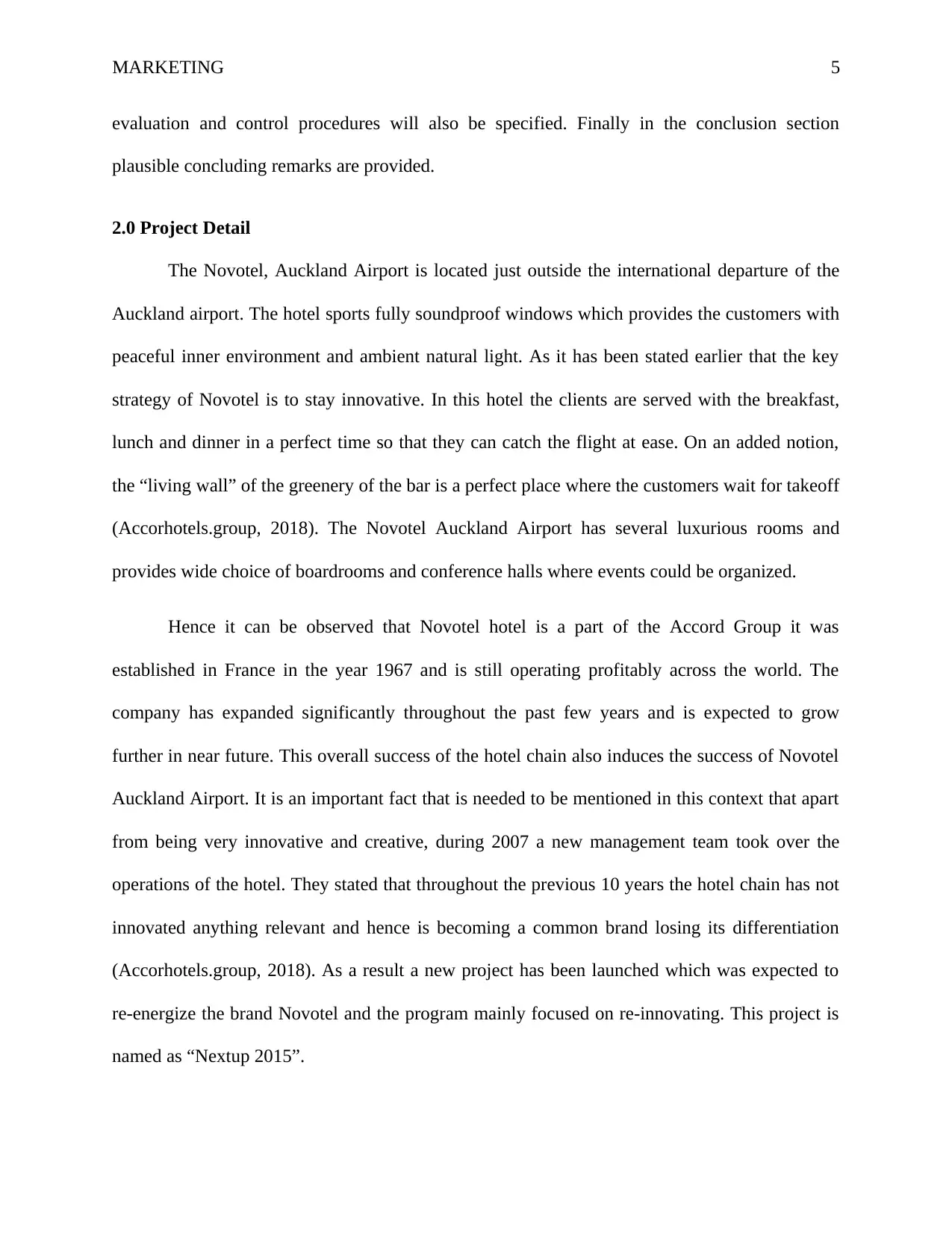
MARKETING 5
evaluation and control procedures will also be specified. Finally in the conclusion section
plausible concluding remarks are provided.
2.0 Project Detail
The Novotel, Auckland Airport is located just outside the international departure of the
Auckland airport. The hotel sports fully soundproof windows which provides the customers with
peaceful inner environment and ambient natural light. As it has been stated earlier that the key
strategy of Novotel is to stay innovative. In this hotel the clients are served with the breakfast,
lunch and dinner in a perfect time so that they can catch the flight at ease. On an added notion,
the “living wall” of the greenery of the bar is a perfect place where the customers wait for takeoff
(Accorhotels.group, 2018). The Novotel Auckland Airport has several luxurious rooms and
provides wide choice of boardrooms and conference halls where events could be organized.
Hence it can be observed that Novotel hotel is a part of the Accord Group it was
established in France in the year 1967 and is still operating profitably across the world. The
company has expanded significantly throughout the past few years and is expected to grow
further in near future. This overall success of the hotel chain also induces the success of Novotel
Auckland Airport. It is an important fact that is needed to be mentioned in this context that apart
from being very innovative and creative, during 2007 a new management team took over the
operations of the hotel. They stated that throughout the previous 10 years the hotel chain has not
innovated anything relevant and hence is becoming a common brand losing its differentiation
(Accorhotels.group, 2018). As a result a new project has been launched which was expected to
re-energize the brand Novotel and the program mainly focused on re-innovating. This project is
named as “Nextup 2015”.
evaluation and control procedures will also be specified. Finally in the conclusion section
plausible concluding remarks are provided.
2.0 Project Detail
The Novotel, Auckland Airport is located just outside the international departure of the
Auckland airport. The hotel sports fully soundproof windows which provides the customers with
peaceful inner environment and ambient natural light. As it has been stated earlier that the key
strategy of Novotel is to stay innovative. In this hotel the clients are served with the breakfast,
lunch and dinner in a perfect time so that they can catch the flight at ease. On an added notion,
the “living wall” of the greenery of the bar is a perfect place where the customers wait for takeoff
(Accorhotels.group, 2018). The Novotel Auckland Airport has several luxurious rooms and
provides wide choice of boardrooms and conference halls where events could be organized.
Hence it can be observed that Novotel hotel is a part of the Accord Group it was
established in France in the year 1967 and is still operating profitably across the world. The
company has expanded significantly throughout the past few years and is expected to grow
further in near future. This overall success of the hotel chain also induces the success of Novotel
Auckland Airport. It is an important fact that is needed to be mentioned in this context that apart
from being very innovative and creative, during 2007 a new management team took over the
operations of the hotel. They stated that throughout the previous 10 years the hotel chain has not
innovated anything relevant and hence is becoming a common brand losing its differentiation
(Accorhotels.group, 2018). As a result a new project has been launched which was expected to
re-energize the brand Novotel and the program mainly focused on re-innovating. This project is
named as “Nextup 2015”.

MARKETING 6
In addition to this program of re-innovating and rejuvenating the brand image of Novotel
the Novotel Auckland Airport has designed a marketing campaign which is aimed at attracting
significantly large number of customers and also increasing the brand awareness of the hotel.
The name of the campaign is,
“Novotel, the best four star hotel of Auckland”
This campaign will last for 90 days, it is planned that if everything goes well the
organization will start the campaign from the 1st of May and it will end on the 30th of July.
Throughout this period the campaign will aim at increasing the brand awareness and attracting
more customers towards the hotel. The experts consulted have also stated that this may also help
to retain the existing customers as well.
3.0 Goal and Objectives
The main goal of this particular marketing campaign of Novotel will be to focus over the
targeted customer groups more specifically. This is because the chance of turning a non-targeted
into a potential buyer is quite less while the targeted customers are more likely to purchase the
products and services offered by the hotel. The campaign will endorse innovative and creative
contents which will present the company information in such a way that attracts the customers
and increases the probability that a person will visit the hotel repeatedly.
The key objectives of the campaign can be stated as follows,
To increase the number of customer of Novotel Auckland Hotel by 50% by the end of the
current year.
To increase the brand awareness and develop a perceived value among the customers and
potential customers of the hotel.
In addition to this program of re-innovating and rejuvenating the brand image of Novotel
the Novotel Auckland Airport has designed a marketing campaign which is aimed at attracting
significantly large number of customers and also increasing the brand awareness of the hotel.
The name of the campaign is,
“Novotel, the best four star hotel of Auckland”
This campaign will last for 90 days, it is planned that if everything goes well the
organization will start the campaign from the 1st of May and it will end on the 30th of July.
Throughout this period the campaign will aim at increasing the brand awareness and attracting
more customers towards the hotel. The experts consulted have also stated that this may also help
to retain the existing customers as well.
3.0 Goal and Objectives
The main goal of this particular marketing campaign of Novotel will be to focus over the
targeted customer groups more specifically. This is because the chance of turning a non-targeted
into a potential buyer is quite less while the targeted customers are more likely to purchase the
products and services offered by the hotel. The campaign will endorse innovative and creative
contents which will present the company information in such a way that attracts the customers
and increases the probability that a person will visit the hotel repeatedly.
The key objectives of the campaign can be stated as follows,
To increase the number of customer of Novotel Auckland Hotel by 50% by the end of the
current year.
To increase the brand awareness and develop a perceived value among the customers and
potential customers of the hotel.
Paraphrase This Document
Need a fresh take? Get an instant paraphrase of this document with our AI Paraphraser
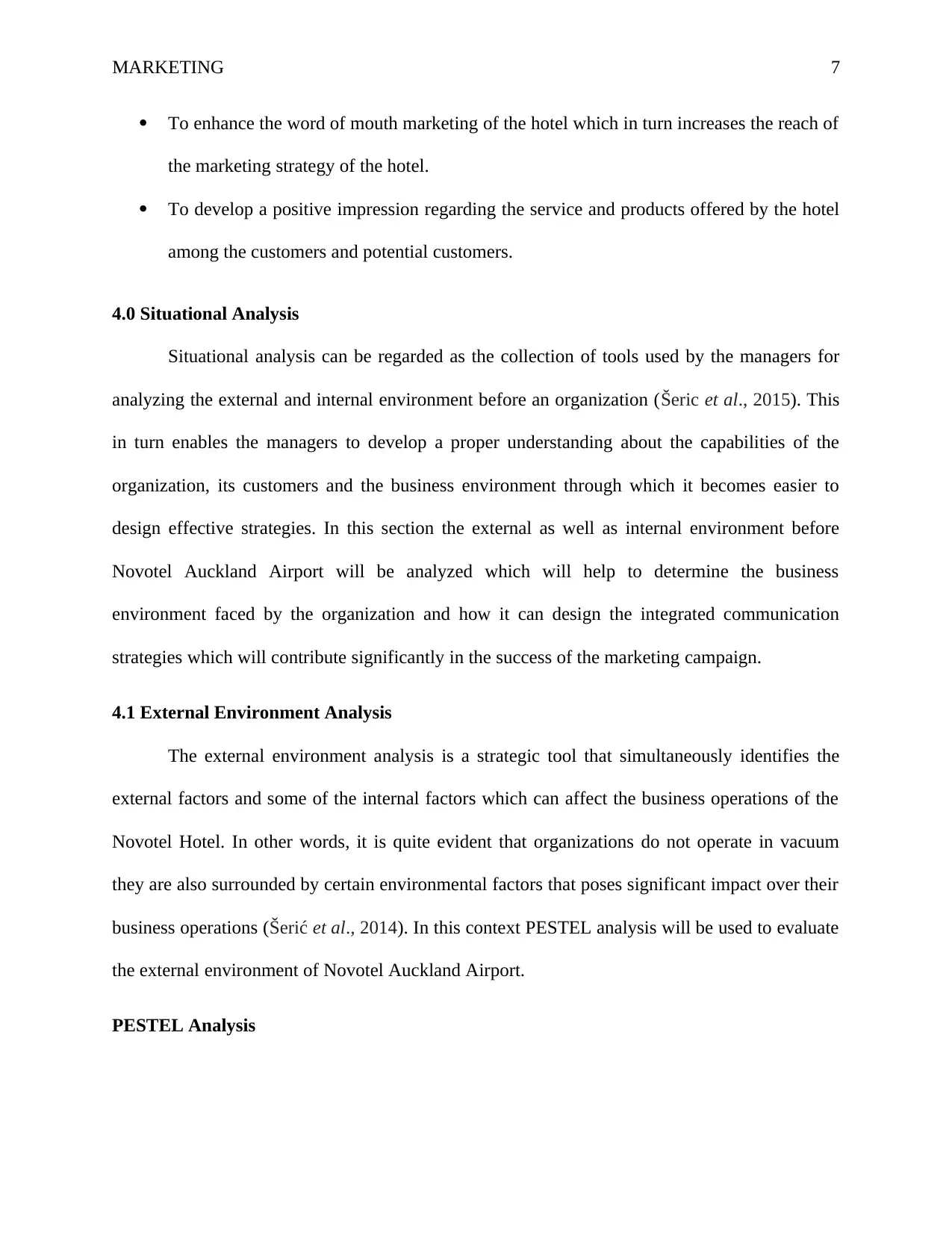
MARKETING 7
To enhance the word of mouth marketing of the hotel which in turn increases the reach of
the marketing strategy of the hotel.
To develop a positive impression regarding the service and products offered by the hotel
among the customers and potential customers.
4.0 Situational Analysis
Situational analysis can be regarded as the collection of tools used by the managers for
analyzing the external and internal environment before an organization (Šeric et al., 2015). This
in turn enables the managers to develop a proper understanding about the capabilities of the
organization, its customers and the business environment through which it becomes easier to
design effective strategies. In this section the external as well as internal environment before
Novotel Auckland Airport will be analyzed which will help to determine the business
environment faced by the organization and how it can design the integrated communication
strategies which will contribute significantly in the success of the marketing campaign.
4.1 External Environment Analysis
The external environment analysis is a strategic tool that simultaneously identifies the
external factors and some of the internal factors which can affect the business operations of the
Novotel Hotel. In other words, it is quite evident that organizations do not operate in vacuum
they are also surrounded by certain environmental factors that poses significant impact over their
business operations (Šerić et al., 2014). In this context PESTEL analysis will be used to evaluate
the external environment of Novotel Auckland Airport.
PESTEL Analysis
To enhance the word of mouth marketing of the hotel which in turn increases the reach of
the marketing strategy of the hotel.
To develop a positive impression regarding the service and products offered by the hotel
among the customers and potential customers.
4.0 Situational Analysis
Situational analysis can be regarded as the collection of tools used by the managers for
analyzing the external and internal environment before an organization (Šeric et al., 2015). This
in turn enables the managers to develop a proper understanding about the capabilities of the
organization, its customers and the business environment through which it becomes easier to
design effective strategies. In this section the external as well as internal environment before
Novotel Auckland Airport will be analyzed which will help to determine the business
environment faced by the organization and how it can design the integrated communication
strategies which will contribute significantly in the success of the marketing campaign.
4.1 External Environment Analysis
The external environment analysis is a strategic tool that simultaneously identifies the
external factors and some of the internal factors which can affect the business operations of the
Novotel Hotel. In other words, it is quite evident that organizations do not operate in vacuum
they are also surrounded by certain environmental factors that poses significant impact over their
business operations (Šerić et al., 2014). In this context PESTEL analysis will be used to evaluate
the external environment of Novotel Auckland Airport.
PESTEL Analysis
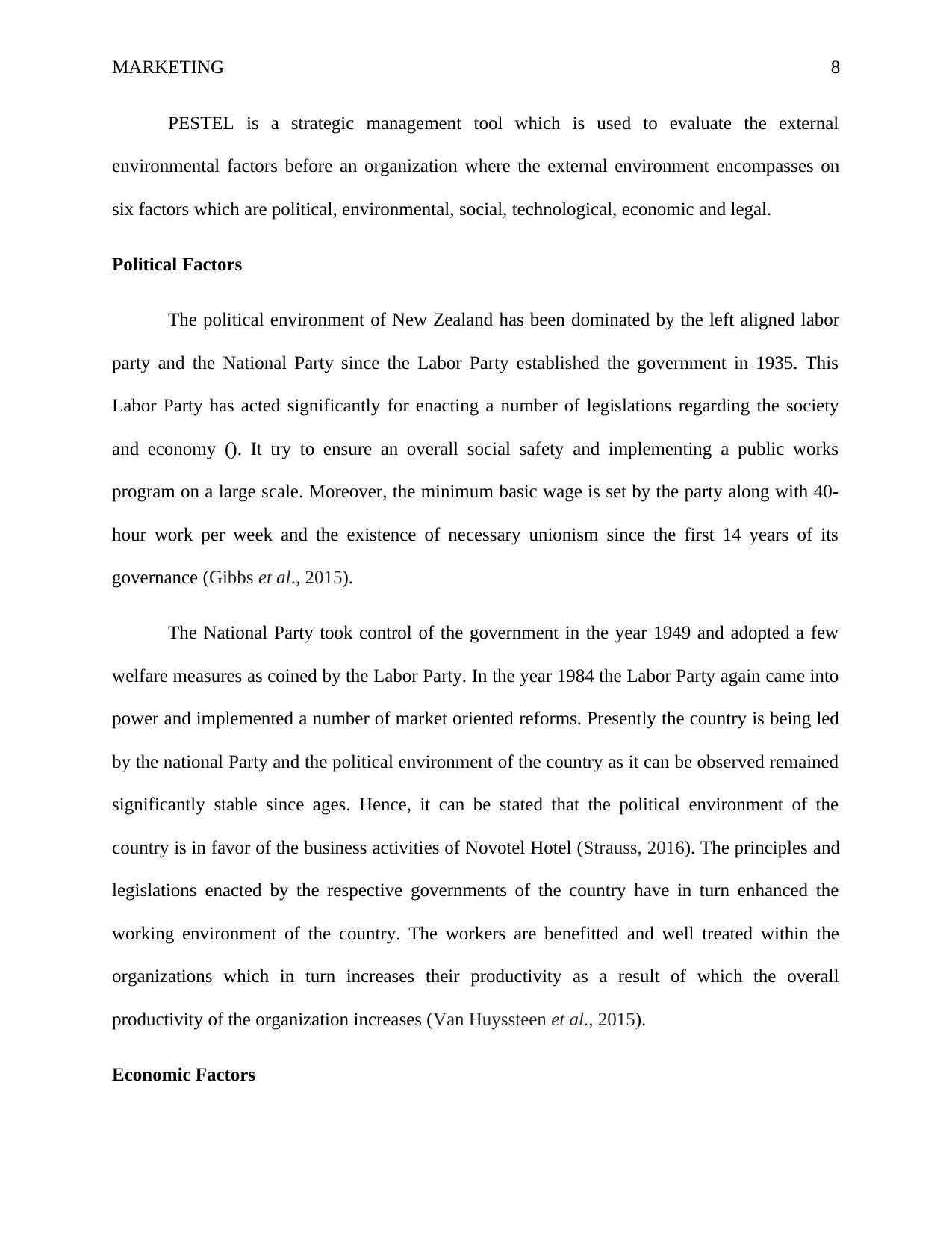
MARKETING 8
PESTEL is a strategic management tool which is used to evaluate the external
environmental factors before an organization where the external environment encompasses on
six factors which are political, environmental, social, technological, economic and legal.
Political Factors
The political environment of New Zealand has been dominated by the left aligned labor
party and the National Party since the Labor Party established the government in 1935. This
Labor Party has acted significantly for enacting a number of legislations regarding the society
and economy (). It try to ensure an overall social safety and implementing a public works
program on a large scale. Moreover, the minimum basic wage is set by the party along with 40-
hour work per week and the existence of necessary unionism since the first 14 years of its
governance (Gibbs et al., 2015).
The National Party took control of the government in the year 1949 and adopted a few
welfare measures as coined by the Labor Party. In the year 1984 the Labor Party again came into
power and implemented a number of market oriented reforms. Presently the country is being led
by the national Party and the political environment of the country as it can be observed remained
significantly stable since ages. Hence, it can be stated that the political environment of the
country is in favor of the business activities of Novotel Hotel (Strauss, 2016). The principles and
legislations enacted by the respective governments of the country have in turn enhanced the
working environment of the country. The workers are benefitted and well treated within the
organizations which in turn increases their productivity as a result of which the overall
productivity of the organization increases (Van Huyssteen et al., 2015).
Economic Factors
PESTEL is a strategic management tool which is used to evaluate the external
environmental factors before an organization where the external environment encompasses on
six factors which are political, environmental, social, technological, economic and legal.
Political Factors
The political environment of New Zealand has been dominated by the left aligned labor
party and the National Party since the Labor Party established the government in 1935. This
Labor Party has acted significantly for enacting a number of legislations regarding the society
and economy (). It try to ensure an overall social safety and implementing a public works
program on a large scale. Moreover, the minimum basic wage is set by the party along with 40-
hour work per week and the existence of necessary unionism since the first 14 years of its
governance (Gibbs et al., 2015).
The National Party took control of the government in the year 1949 and adopted a few
welfare measures as coined by the Labor Party. In the year 1984 the Labor Party again came into
power and implemented a number of market oriented reforms. Presently the country is being led
by the national Party and the political environment of the country as it can be observed remained
significantly stable since ages. Hence, it can be stated that the political environment of the
country is in favor of the business activities of Novotel Hotel (Strauss, 2016). The principles and
legislations enacted by the respective governments of the country have in turn enhanced the
working environment of the country. The workers are benefitted and well treated within the
organizations which in turn increases their productivity as a result of which the overall
productivity of the organization increases (Van Huyssteen et al., 2015).
Economic Factors
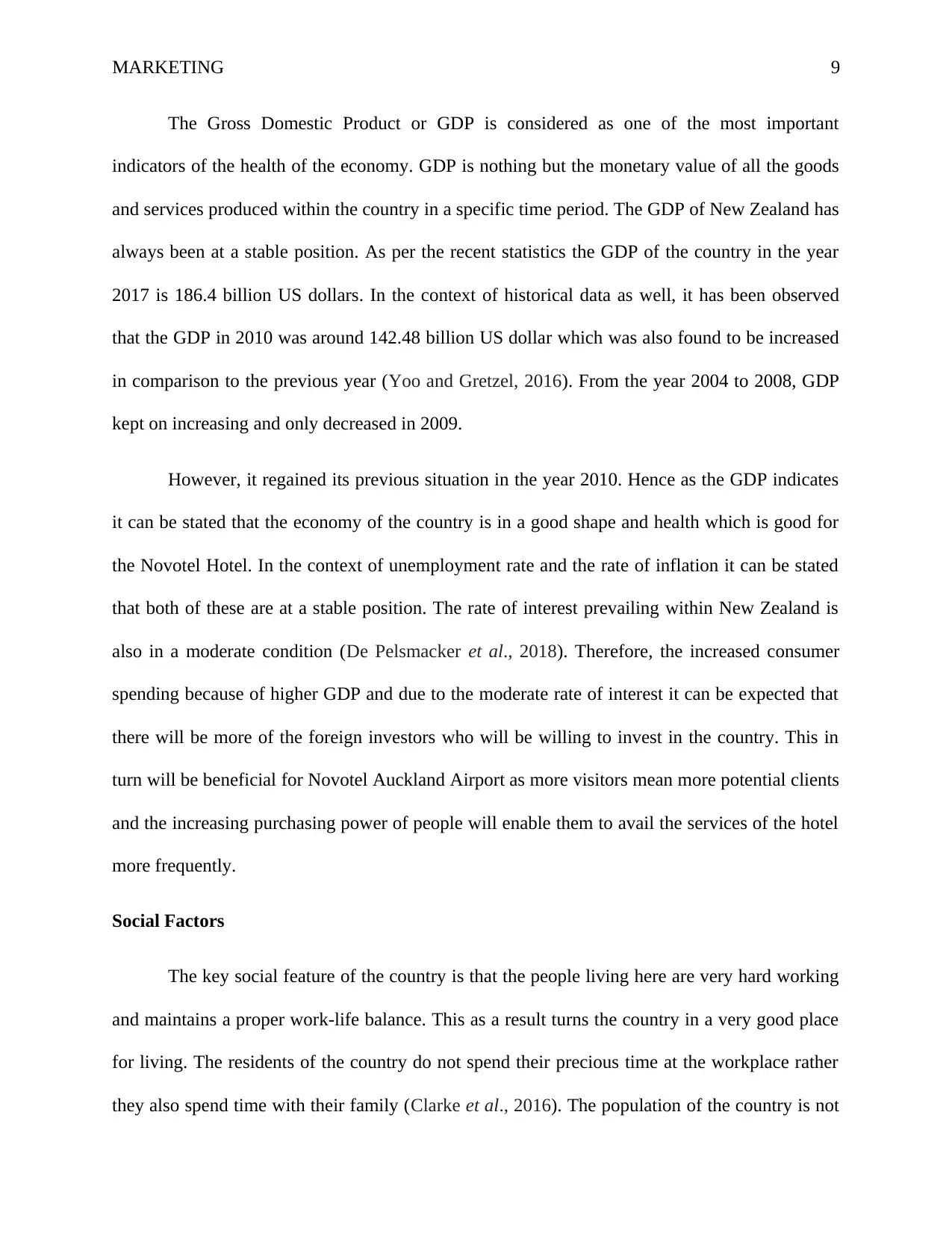
MARKETING 9
The Gross Domestic Product or GDP is considered as one of the most important
indicators of the health of the economy. GDP is nothing but the monetary value of all the goods
and services produced within the country in a specific time period. The GDP of New Zealand has
always been at a stable position. As per the recent statistics the GDP of the country in the year
2017 is 186.4 billion US dollars. In the context of historical data as well, it has been observed
that the GDP in 2010 was around 142.48 billion US dollar which was also found to be increased
in comparison to the previous year (Yoo and Gretzel, 2016). From the year 2004 to 2008, GDP
kept on increasing and only decreased in 2009.
However, it regained its previous situation in the year 2010. Hence as the GDP indicates
it can be stated that the economy of the country is in a good shape and health which is good for
the Novotel Hotel. In the context of unemployment rate and the rate of inflation it can be stated
that both of these are at a stable position. The rate of interest prevailing within New Zealand is
also in a moderate condition (De Pelsmacker et al., 2018). Therefore, the increased consumer
spending because of higher GDP and due to the moderate rate of interest it can be expected that
there will be more of the foreign investors who will be willing to invest in the country. This in
turn will be beneficial for Novotel Auckland Airport as more visitors mean more potential clients
and the increasing purchasing power of people will enable them to avail the services of the hotel
more frequently.
Social Factors
The key social feature of the country is that the people living here are very hard working
and maintains a proper work-life balance. This as a result turns the country in a very good place
for living. The residents of the country do not spend their precious time at the workplace rather
they also spend time with their family (Clarke et al., 2016). The population of the country is not
The Gross Domestic Product or GDP is considered as one of the most important
indicators of the health of the economy. GDP is nothing but the monetary value of all the goods
and services produced within the country in a specific time period. The GDP of New Zealand has
always been at a stable position. As per the recent statistics the GDP of the country in the year
2017 is 186.4 billion US dollars. In the context of historical data as well, it has been observed
that the GDP in 2010 was around 142.48 billion US dollar which was also found to be increased
in comparison to the previous year (Yoo and Gretzel, 2016). From the year 2004 to 2008, GDP
kept on increasing and only decreased in 2009.
However, it regained its previous situation in the year 2010. Hence as the GDP indicates
it can be stated that the economy of the country is in a good shape and health which is good for
the Novotel Hotel. In the context of unemployment rate and the rate of inflation it can be stated
that both of these are at a stable position. The rate of interest prevailing within New Zealand is
also in a moderate condition (De Pelsmacker et al., 2018). Therefore, the increased consumer
spending because of higher GDP and due to the moderate rate of interest it can be expected that
there will be more of the foreign investors who will be willing to invest in the country. This in
turn will be beneficial for Novotel Auckland Airport as more visitors mean more potential clients
and the increasing purchasing power of people will enable them to avail the services of the hotel
more frequently.
Social Factors
The key social feature of the country is that the people living here are very hard working
and maintains a proper work-life balance. This as a result turns the country in a very good place
for living. The residents of the country do not spend their precious time at the workplace rather
they also spend time with their family (Clarke et al., 2016). The population of the country is not
Secure Best Marks with AI Grader
Need help grading? Try our AI Grader for instant feedback on your assignments.
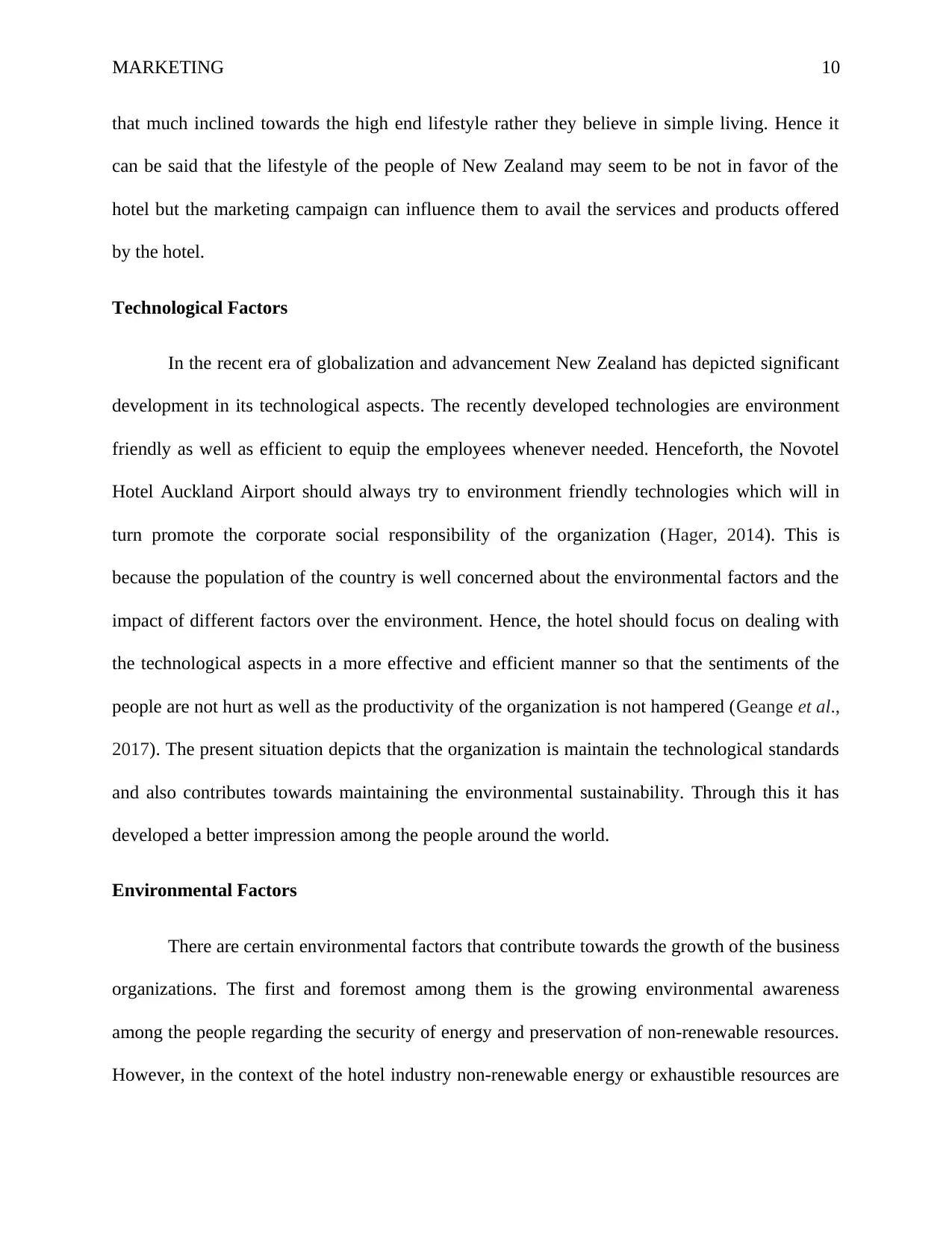
MARKETING 10
that much inclined towards the high end lifestyle rather they believe in simple living. Hence it
can be said that the lifestyle of the people of New Zealand may seem to be not in favor of the
hotel but the marketing campaign can influence them to avail the services and products offered
by the hotel.
Technological Factors
In the recent era of globalization and advancement New Zealand has depicted significant
development in its technological aspects. The recently developed technologies are environment
friendly as well as efficient to equip the employees whenever needed. Henceforth, the Novotel
Hotel Auckland Airport should always try to environment friendly technologies which will in
turn promote the corporate social responsibility of the organization (Hager, 2014). This is
because the population of the country is well concerned about the environmental factors and the
impact of different factors over the environment. Hence, the hotel should focus on dealing with
the technological aspects in a more effective and efficient manner so that the sentiments of the
people are not hurt as well as the productivity of the organization is not hampered (Geange et al.,
2017). The present situation depicts that the organization is maintain the technological standards
and also contributes towards maintaining the environmental sustainability. Through this it has
developed a better impression among the people around the world.
Environmental Factors
There are certain environmental factors that contribute towards the growth of the business
organizations. The first and foremost among them is the growing environmental awareness
among the people regarding the security of energy and preservation of non-renewable resources.
However, in the context of the hotel industry non-renewable energy or exhaustible resources are
that much inclined towards the high end lifestyle rather they believe in simple living. Hence it
can be said that the lifestyle of the people of New Zealand may seem to be not in favor of the
hotel but the marketing campaign can influence them to avail the services and products offered
by the hotel.
Technological Factors
In the recent era of globalization and advancement New Zealand has depicted significant
development in its technological aspects. The recently developed technologies are environment
friendly as well as efficient to equip the employees whenever needed. Henceforth, the Novotel
Hotel Auckland Airport should always try to environment friendly technologies which will in
turn promote the corporate social responsibility of the organization (Hager, 2014). This is
because the population of the country is well concerned about the environmental factors and the
impact of different factors over the environment. Hence, the hotel should focus on dealing with
the technological aspects in a more effective and efficient manner so that the sentiments of the
people are not hurt as well as the productivity of the organization is not hampered (Geange et al.,
2017). The present situation depicts that the organization is maintain the technological standards
and also contributes towards maintaining the environmental sustainability. Through this it has
developed a better impression among the people around the world.
Environmental Factors
There are certain environmental factors that contribute towards the growth of the business
organizations. The first and foremost among them is the growing environmental awareness
among the people regarding the security of energy and preservation of non-renewable resources.
However, in the context of the hotel industry non-renewable energy or exhaustible resources are
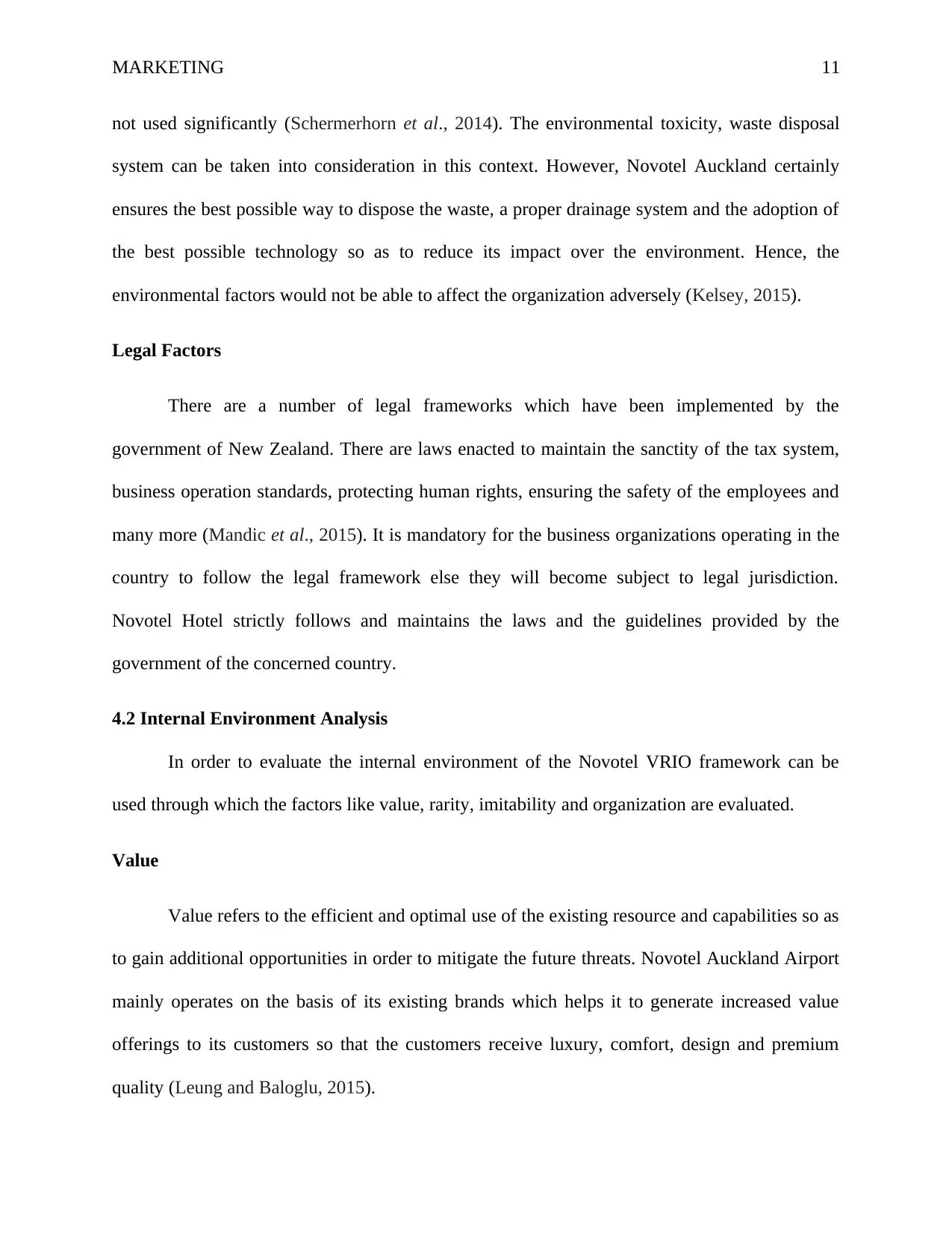
MARKETING 11
not used significantly (Schermerhorn et al., 2014). The environmental toxicity, waste disposal
system can be taken into consideration in this context. However, Novotel Auckland certainly
ensures the best possible way to dispose the waste, a proper drainage system and the adoption of
the best possible technology so as to reduce its impact over the environment. Hence, the
environmental factors would not be able to affect the organization adversely (Kelsey, 2015).
Legal Factors
There are a number of legal frameworks which have been implemented by the
government of New Zealand. There are laws enacted to maintain the sanctity of the tax system,
business operation standards, protecting human rights, ensuring the safety of the employees and
many more (Mandic et al., 2015). It is mandatory for the business organizations operating in the
country to follow the legal framework else they will become subject to legal jurisdiction.
Novotel Hotel strictly follows and maintains the laws and the guidelines provided by the
government of the concerned country.
4.2 Internal Environment Analysis
In order to evaluate the internal environment of the Novotel VRIO framework can be
used through which the factors like value, rarity, imitability and organization are evaluated.
Value
Value refers to the efficient and optimal use of the existing resource and capabilities so as
to gain additional opportunities in order to mitigate the future threats. Novotel Auckland Airport
mainly operates on the basis of its existing brands which helps it to generate increased value
offerings to its customers so that the customers receive luxury, comfort, design and premium
quality (Leung and Baloglu, 2015).
not used significantly (Schermerhorn et al., 2014). The environmental toxicity, waste disposal
system can be taken into consideration in this context. However, Novotel Auckland certainly
ensures the best possible way to dispose the waste, a proper drainage system and the adoption of
the best possible technology so as to reduce its impact over the environment. Hence, the
environmental factors would not be able to affect the organization adversely (Kelsey, 2015).
Legal Factors
There are a number of legal frameworks which have been implemented by the
government of New Zealand. There are laws enacted to maintain the sanctity of the tax system,
business operation standards, protecting human rights, ensuring the safety of the employees and
many more (Mandic et al., 2015). It is mandatory for the business organizations operating in the
country to follow the legal framework else they will become subject to legal jurisdiction.
Novotel Hotel strictly follows and maintains the laws and the guidelines provided by the
government of the concerned country.
4.2 Internal Environment Analysis
In order to evaluate the internal environment of the Novotel VRIO framework can be
used through which the factors like value, rarity, imitability and organization are evaluated.
Value
Value refers to the efficient and optimal use of the existing resource and capabilities so as
to gain additional opportunities in order to mitigate the future threats. Novotel Auckland Airport
mainly operates on the basis of its existing brands which helps it to generate increased value
offerings to its customers so that the customers receive luxury, comfort, design and premium
quality (Leung and Baloglu, 2015).

MARKETING 12
Rarity
The rarity of the resources or the services possessed by an organization also contributes
on increasing the competitive advantage of the organization. The business model of Novotel is
based on working as a chain of luxury hotels and it provides the customers with luxury
accommodation at an affordable price (Finne and Grönroos, 2017). This is some kind of a rare
service which is currently not being provided by the other organizations in New Zealand.
Imitability
The imitability parameter refers to the fact that how easy it is for an organization in the
market to copy the resources and services of the organization. However, the business model of
Novotel is completely based on providing value to the customers with innovative and quality
services (Saenko et al., 2016). At the same time the company also connects with the customers
over the internet, it enables the customers to book and reserve online. It will certainly be difficult
for an organization to imitate these because it would be costly.
Organization
This specific parameter focuses on evaluating the potential capability of the organization
to exploit the available resources. Novotel stresses on continuous improvement of the skillset of
its workforce through training and development programs (Pismennaya, 2016). This in turn
enables the organization to equip the workforce with the necessary skillsets so that they can
generate innovative services and provide sophisticated products and services to the customers.
Rarity
The rarity of the resources or the services possessed by an organization also contributes
on increasing the competitive advantage of the organization. The business model of Novotel is
based on working as a chain of luxury hotels and it provides the customers with luxury
accommodation at an affordable price (Finne and Grönroos, 2017). This is some kind of a rare
service which is currently not being provided by the other organizations in New Zealand.
Imitability
The imitability parameter refers to the fact that how easy it is for an organization in the
market to copy the resources and services of the organization. However, the business model of
Novotel is completely based on providing value to the customers with innovative and quality
services (Saenko et al., 2016). At the same time the company also connects with the customers
over the internet, it enables the customers to book and reserve online. It will certainly be difficult
for an organization to imitate these because it would be costly.
Organization
This specific parameter focuses on evaluating the potential capability of the organization
to exploit the available resources. Novotel stresses on continuous improvement of the skillset of
its workforce through training and development programs (Pismennaya, 2016). This in turn
enables the organization to equip the workforce with the necessary skillsets so that they can
generate innovative services and provide sophisticated products and services to the customers.
Paraphrase This Document
Need a fresh take? Get an instant paraphrase of this document with our AI Paraphraser

MARKETING 13
5.0 Target Market
In order to determine the most suitable population which is needed to be targeted the STP
tool can be used. STP actually stands for segmentation, targeting and positioning strategy of an
organization.
5.1 STP Analysis
Segmentation
In this stage the organization segregates the market in different segments and finds the
most suitable segment which will be targeted. In the case of Novotel Auckland Airport,
demographic and psychographic segmentation will be used. The entire relevant population of
New Zealand can be divided into three segments which are 18 to 35, 35 to 55, 55 and above. In
this context the age group ranging from 35 to 55 will be most relevant for Novotel as most of the
people in this age group are working and earn regularly (Porcu et al., 2017). A proportion of the
age group 18 to 35 will also be considered as well. It is expected that the people who have a
regular income are more likely to spend on luxury goods and services.
As per the psychographic segmentation the population can again be divided into different
parts on the basis of their lifestyle. It involves identifying the people with same type of choice
and preferences. Targeting these people with similar tastes and preferences will make it easier
for the organization to address a large number of people at one go.
Targeting
After the identification of different segments it is quite evident that different segments
will be targeted. In this context the people within age group 18 to 35 and 35 to 55 will mainly be
targeted. Further the hotel will try to identify the people with similar lifestyle choices through
5.0 Target Market
In order to determine the most suitable population which is needed to be targeted the STP
tool can be used. STP actually stands for segmentation, targeting and positioning strategy of an
organization.
5.1 STP Analysis
Segmentation
In this stage the organization segregates the market in different segments and finds the
most suitable segment which will be targeted. In the case of Novotel Auckland Airport,
demographic and psychographic segmentation will be used. The entire relevant population of
New Zealand can be divided into three segments which are 18 to 35, 35 to 55, 55 and above. In
this context the age group ranging from 35 to 55 will be most relevant for Novotel as most of the
people in this age group are working and earn regularly (Porcu et al., 2017). A proportion of the
age group 18 to 35 will also be considered as well. It is expected that the people who have a
regular income are more likely to spend on luxury goods and services.
As per the psychographic segmentation the population can again be divided into different
parts on the basis of their lifestyle. It involves identifying the people with same type of choice
and preferences. Targeting these people with similar tastes and preferences will make it easier
for the organization to address a large number of people at one go.
Targeting
After the identification of different segments it is quite evident that different segments
will be targeted. In this context the people within age group 18 to 35 and 35 to 55 will mainly be
targeted. Further the hotel will try to identify the people with similar lifestyle choices through

MARKETING 14
observing their behavior over the internet. Metropolitan and capital cities will also be targeted as
here the majority of the market of Novotel will be found among the professionals and cultured
travelers (Hossain et al., 2017).
Positioning
In terms of positioning it can be stated that the organization will position itself in the high
price high quality segment. However, in comparison to the other similar organization operating
in the same segment it will maintain a relatively low price. This is the strategy of the
organization to cope with the market threats in the extensively competitive marketplace (Buhalis
and Mamalakis, 2015).
6.0 Budgeting
Campaigning Budget
Social Media -
Website Campaigning $40,000
Organizing Promotional Events $25,000
Print Media Advertising $15,000
Billboards $3000
Television Advertising $5000
7.0 IMC Strategy
Integrated marketing communication can be defined as the activity that recognizes the
value of a comprehensive plan that in turn examines the strategic roles that are played by
different disciplines of communication such as advertising, sales promotion, personal selling and
observing their behavior over the internet. Metropolitan and capital cities will also be targeted as
here the majority of the market of Novotel will be found among the professionals and cultured
travelers (Hossain et al., 2017).
Positioning
In terms of positioning it can be stated that the organization will position itself in the high
price high quality segment. However, in comparison to the other similar organization operating
in the same segment it will maintain a relatively low price. This is the strategy of the
organization to cope with the market threats in the extensively competitive marketplace (Buhalis
and Mamalakis, 2015).
6.0 Budgeting
Campaigning Budget
Social Media -
Website Campaigning $40,000
Organizing Promotional Events $25,000
Print Media Advertising $15,000
Billboards $3000
Television Advertising $5000
7.0 IMC Strategy
Integrated marketing communication can be defined as the activity that recognizes the
value of a comprehensive plan that in turn examines the strategic roles that are played by
different disciplines of communication such as advertising, sales promotion, personal selling and
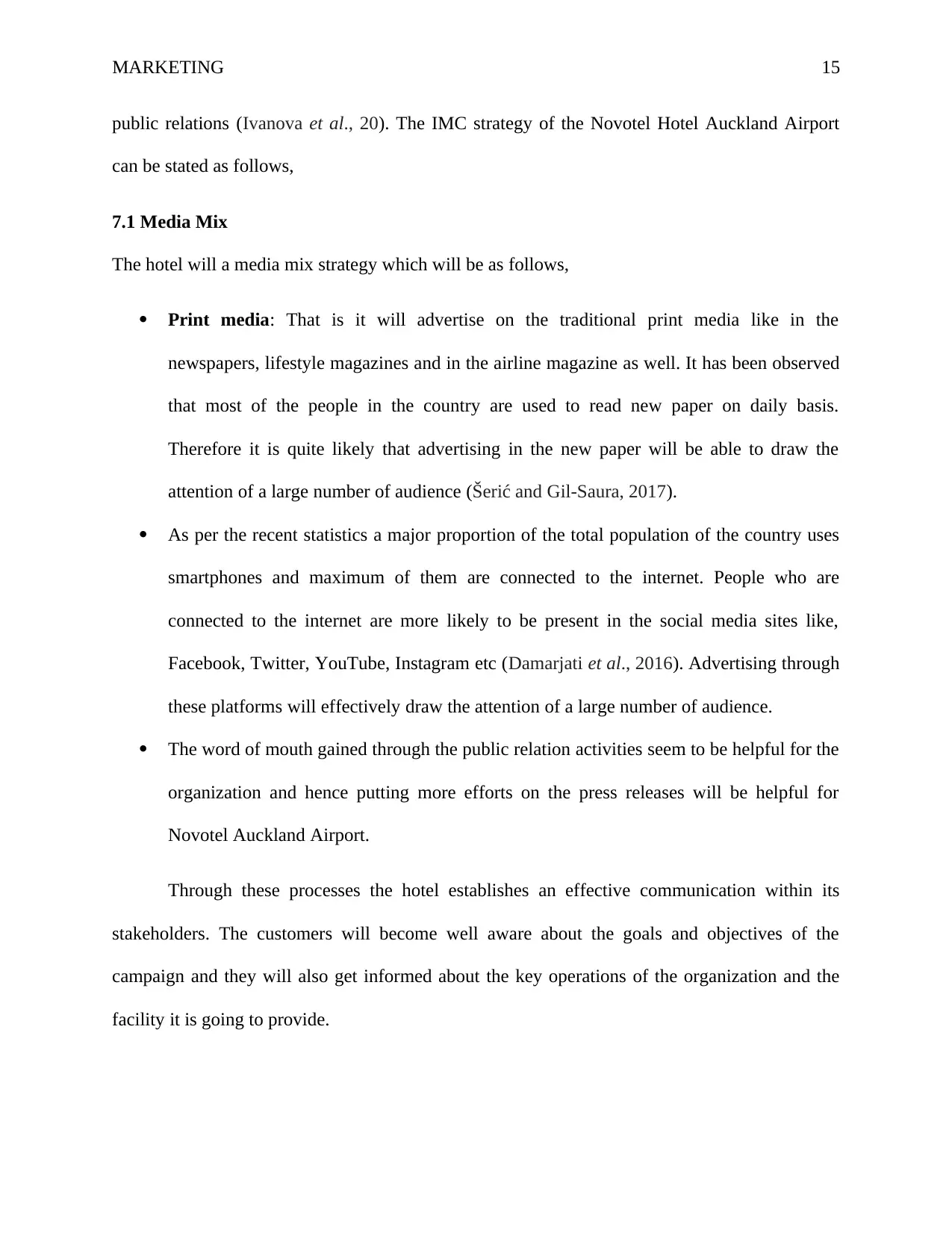
MARKETING 15
public relations (Ivanova et al., 20). The IMC strategy of the Novotel Hotel Auckland Airport
can be stated as follows,
7.1 Media Mix
The hotel will a media mix strategy which will be as follows,
Print media: That is it will advertise on the traditional print media like in the
newspapers, lifestyle magazines and in the airline magazine as well. It has been observed
that most of the people in the country are used to read new paper on daily basis.
Therefore it is quite likely that advertising in the new paper will be able to draw the
attention of a large number of audience (Šerić and Gil-Saura, 2017).
As per the recent statistics a major proportion of the total population of the country uses
smartphones and maximum of them are connected to the internet. People who are
connected to the internet are more likely to be present in the social media sites like,
Facebook, Twitter, YouTube, Instagram etc (Damarjati et al., 2016). Advertising through
these platforms will effectively draw the attention of a large number of audience.
The word of mouth gained through the public relation activities seem to be helpful for the
organization and hence putting more efforts on the press releases will be helpful for
Novotel Auckland Airport.
Through these processes the hotel establishes an effective communication within its
stakeholders. The customers will become well aware about the goals and objectives of the
campaign and they will also get informed about the key operations of the organization and the
facility it is going to provide.
public relations (Ivanova et al., 20). The IMC strategy of the Novotel Hotel Auckland Airport
can be stated as follows,
7.1 Media Mix
The hotel will a media mix strategy which will be as follows,
Print media: That is it will advertise on the traditional print media like in the
newspapers, lifestyle magazines and in the airline magazine as well. It has been observed
that most of the people in the country are used to read new paper on daily basis.
Therefore it is quite likely that advertising in the new paper will be able to draw the
attention of a large number of audience (Šerić and Gil-Saura, 2017).
As per the recent statistics a major proportion of the total population of the country uses
smartphones and maximum of them are connected to the internet. People who are
connected to the internet are more likely to be present in the social media sites like,
Facebook, Twitter, YouTube, Instagram etc (Damarjati et al., 2016). Advertising through
these platforms will effectively draw the attention of a large number of audience.
The word of mouth gained through the public relation activities seem to be helpful for the
organization and hence putting more efforts on the press releases will be helpful for
Novotel Auckland Airport.
Through these processes the hotel establishes an effective communication within its
stakeholders. The customers will become well aware about the goals and objectives of the
campaign and they will also get informed about the key operations of the organization and the
facility it is going to provide.
Secure Best Marks with AI Grader
Need help grading? Try our AI Grader for instant feedback on your assignments.
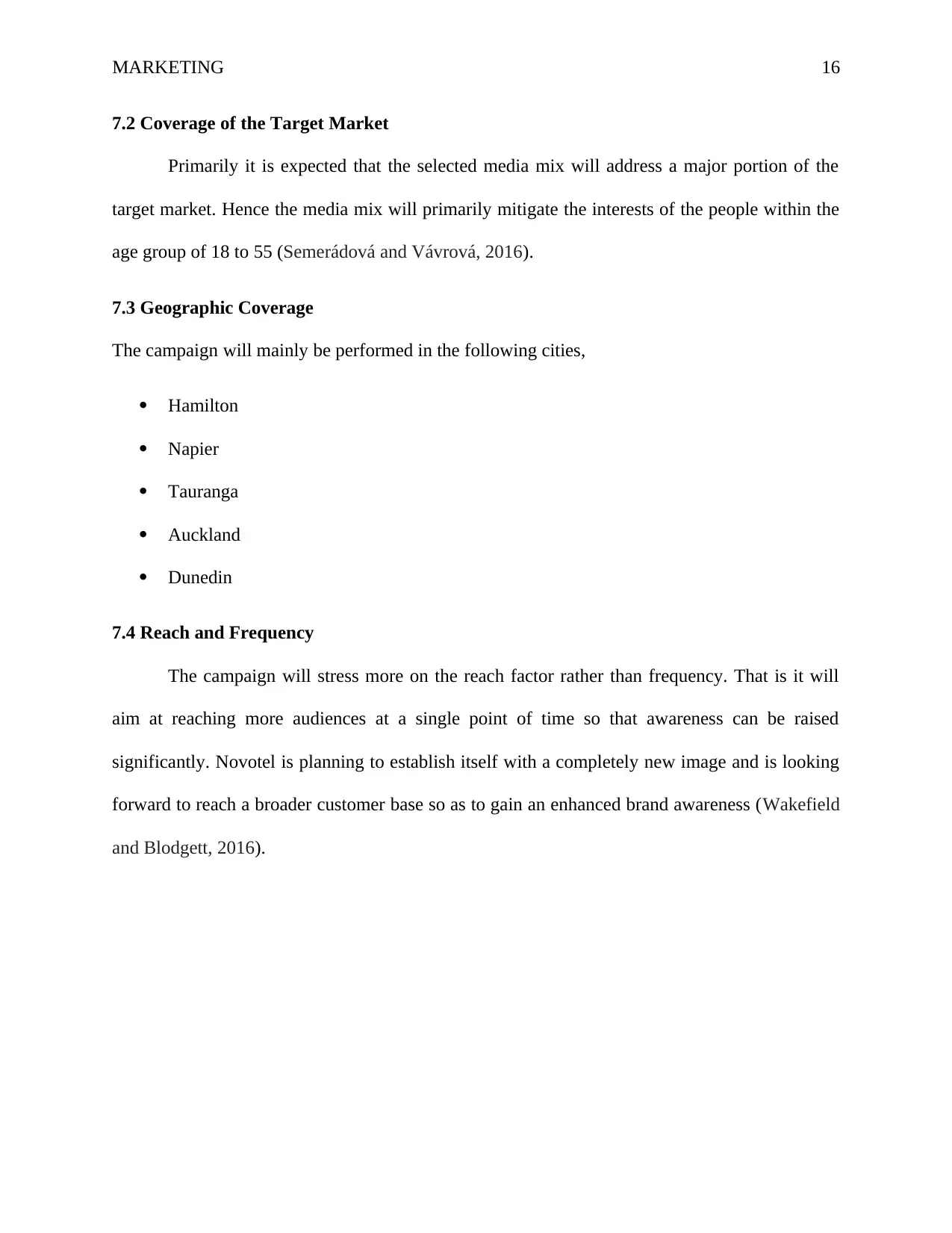
MARKETING 16
7.2 Coverage of the Target Market
Primarily it is expected that the selected media mix will address a major portion of the
target market. Hence the media mix will primarily mitigate the interests of the people within the
age group of 18 to 55 (Semerádová and Vávrová, 2016).
7.3 Geographic Coverage
The campaign will mainly be performed in the following cities,
Hamilton
Napier
Tauranga
Auckland
Dunedin
7.4 Reach and Frequency
The campaign will stress more on the reach factor rather than frequency. That is it will
aim at reaching more audiences at a single point of time so that awareness can be raised
significantly. Novotel is planning to establish itself with a completely new image and is looking
forward to reach a broader customer base so as to gain an enhanced brand awareness (Wakefield
and Blodgett, 2016).
7.2 Coverage of the Target Market
Primarily it is expected that the selected media mix will address a major portion of the
target market. Hence the media mix will primarily mitigate the interests of the people within the
age group of 18 to 55 (Semerádová and Vávrová, 2016).
7.3 Geographic Coverage
The campaign will mainly be performed in the following cities,
Hamilton
Napier
Tauranga
Auckland
Dunedin
7.4 Reach and Frequency
The campaign will stress more on the reach factor rather than frequency. That is it will
aim at reaching more audiences at a single point of time so that awareness can be raised
significantly. Novotel is planning to establish itself with a completely new image and is looking
forward to reach a broader customer base so as to gain an enhanced brand awareness (Wakefield
and Blodgett, 2016).
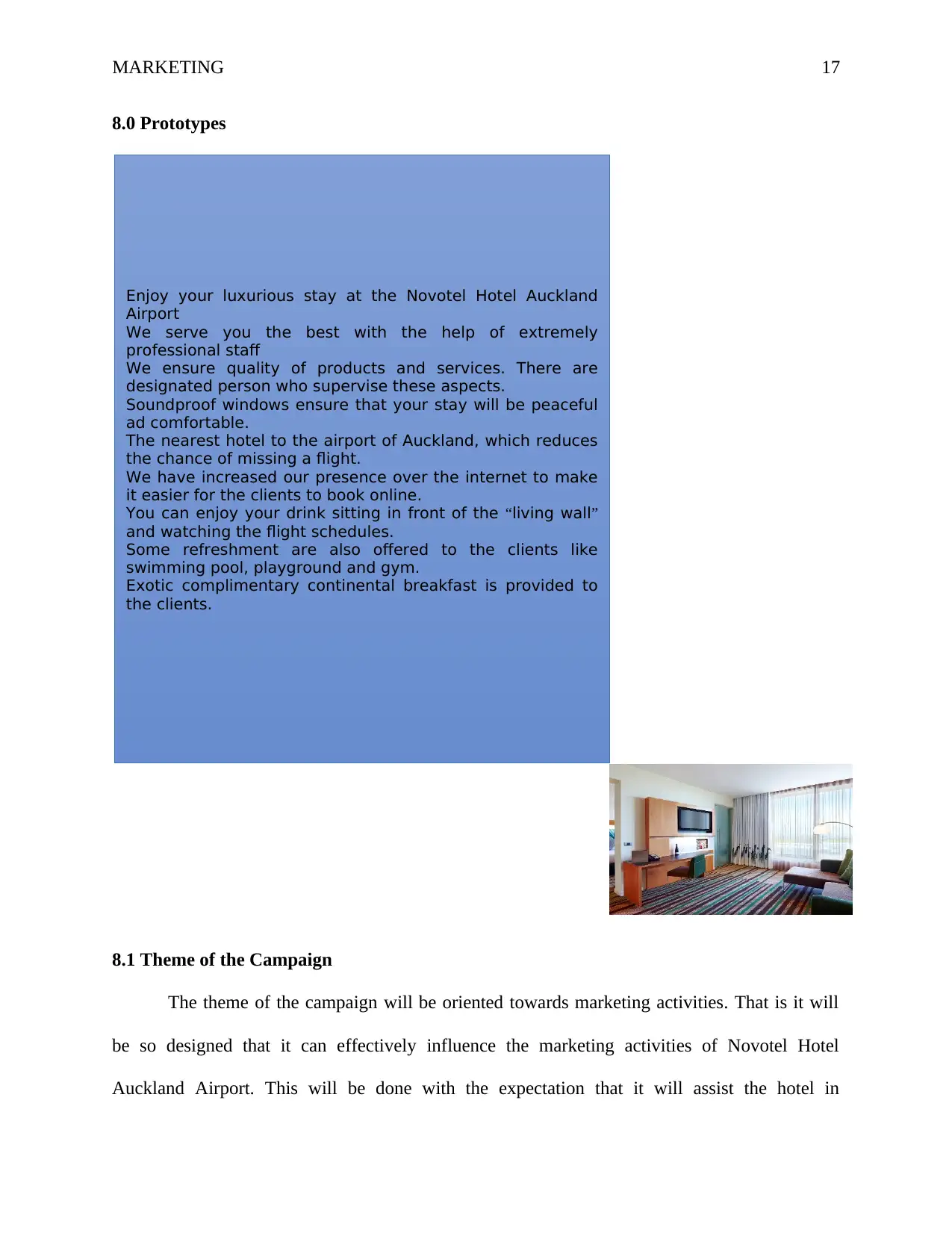
Enjoy your luxurious stay at the Novotel Hotel Auckland
Airport
We serve you the best with the help of extremely
professional staff
We ensure quality of products and services. There are
designated person who supervise these aspects.
Soundproof windows ensure that your stay will be peaceful
ad comfortable.
The nearest hotel to the airport of Auckland, which reduces
the chance of missing a flight.
We have increased our presence over the internet to make
it easier for the clients to book online.
You can enjoy your drink sitting in front of the “living wall”
and watching the flight schedules.
Some refreshment are also offered to the clients like
swimming pool, playground and gym.
Exotic complimentary continental breakfast is provided to
the clients.
MARKETING 17
8.0 Prototypes
8.1 Theme of the Campaign
The theme of the campaign will be oriented towards marketing activities. That is it will
be so designed that it can effectively influence the marketing activities of Novotel Hotel
Auckland Airport. This will be done with the expectation that it will assist the hotel in
Airport
We serve you the best with the help of extremely
professional staff
We ensure quality of products and services. There are
designated person who supervise these aspects.
Soundproof windows ensure that your stay will be peaceful
ad comfortable.
The nearest hotel to the airport of Auckland, which reduces
the chance of missing a flight.
We have increased our presence over the internet to make
it easier for the clients to book online.
You can enjoy your drink sitting in front of the “living wall”
and watching the flight schedules.
Some refreshment are also offered to the clients like
swimming pool, playground and gym.
Exotic complimentary continental breakfast is provided to
the clients.
MARKETING 17
8.0 Prototypes
8.1 Theme of the Campaign
The theme of the campaign will be oriented towards marketing activities. That is it will
be so designed that it can effectively influence the marketing activities of Novotel Hotel
Auckland Airport. This will be done with the expectation that it will assist the hotel in

MARKETING 18
establishing itself as a renowned brand in that location and attract the attention of a significantly
large base of customers (Felix et al., 2017).
8.2 Message of the Campaign
The campaign will spread the message that Novotel Auckland Airport is the best option
for staying as it is situated near the airport which is convenient for the professional travelers
(Yildiz, 2015). Moreover, in the context of tourists they can enjoy their luxurious stay at the
hotel with exotic foods and enjoy the picturesque natural beauty of the locality from the hotel
room.
9.0 Implementation Plan
Project Milestone
Parameters Duratio
n Start Finish
Situational Analysis 5 days Tue 5/1/18 Mon 5/7/18
External Environment Analysis 15 days Mon 5/7/18 Fri 5/25/18
Internal Environment Analysis 15 days Fri 5/25/18 Thu 6/14/18
Target Market Analysis 10 days Thu 6/14/18 Wed 6/27/18
Budgeting 10 days Wed 6/27/18 Tue 7/10/18
Implementing IMC Strategy 5 days Tue 7/10/18 Mon 7/16/18
Modelling Prototypes 10 days Mon 7/16/18 Fri 7/27/18
Implementation Plan 12 days Fri 7/27/18 Mon 8/13/18
Evaluation and Control 8 days Mon 8/13/18 Wed 8/22/18
Total Duration 90 Days
establishing itself as a renowned brand in that location and attract the attention of a significantly
large base of customers (Felix et al., 2017).
8.2 Message of the Campaign
The campaign will spread the message that Novotel Auckland Airport is the best option
for staying as it is situated near the airport which is convenient for the professional travelers
(Yildiz, 2015). Moreover, in the context of tourists they can enjoy their luxurious stay at the
hotel with exotic foods and enjoy the picturesque natural beauty of the locality from the hotel
room.
9.0 Implementation Plan
Project Milestone
Parameters Duratio
n Start Finish
Situational Analysis 5 days Tue 5/1/18 Mon 5/7/18
External Environment Analysis 15 days Mon 5/7/18 Fri 5/25/18
Internal Environment Analysis 15 days Fri 5/25/18 Thu 6/14/18
Target Market Analysis 10 days Thu 6/14/18 Wed 6/27/18
Budgeting 10 days Wed 6/27/18 Tue 7/10/18
Implementing IMC Strategy 5 days Tue 7/10/18 Mon 7/16/18
Modelling Prototypes 10 days Mon 7/16/18 Fri 7/27/18
Implementation Plan 12 days Fri 7/27/18 Mon 8/13/18
Evaluation and Control 8 days Mon 8/13/18 Wed 8/22/18
Total Duration 90 Days
Paraphrase This Document
Need a fresh take? Get an instant paraphrase of this document with our AI Paraphraser
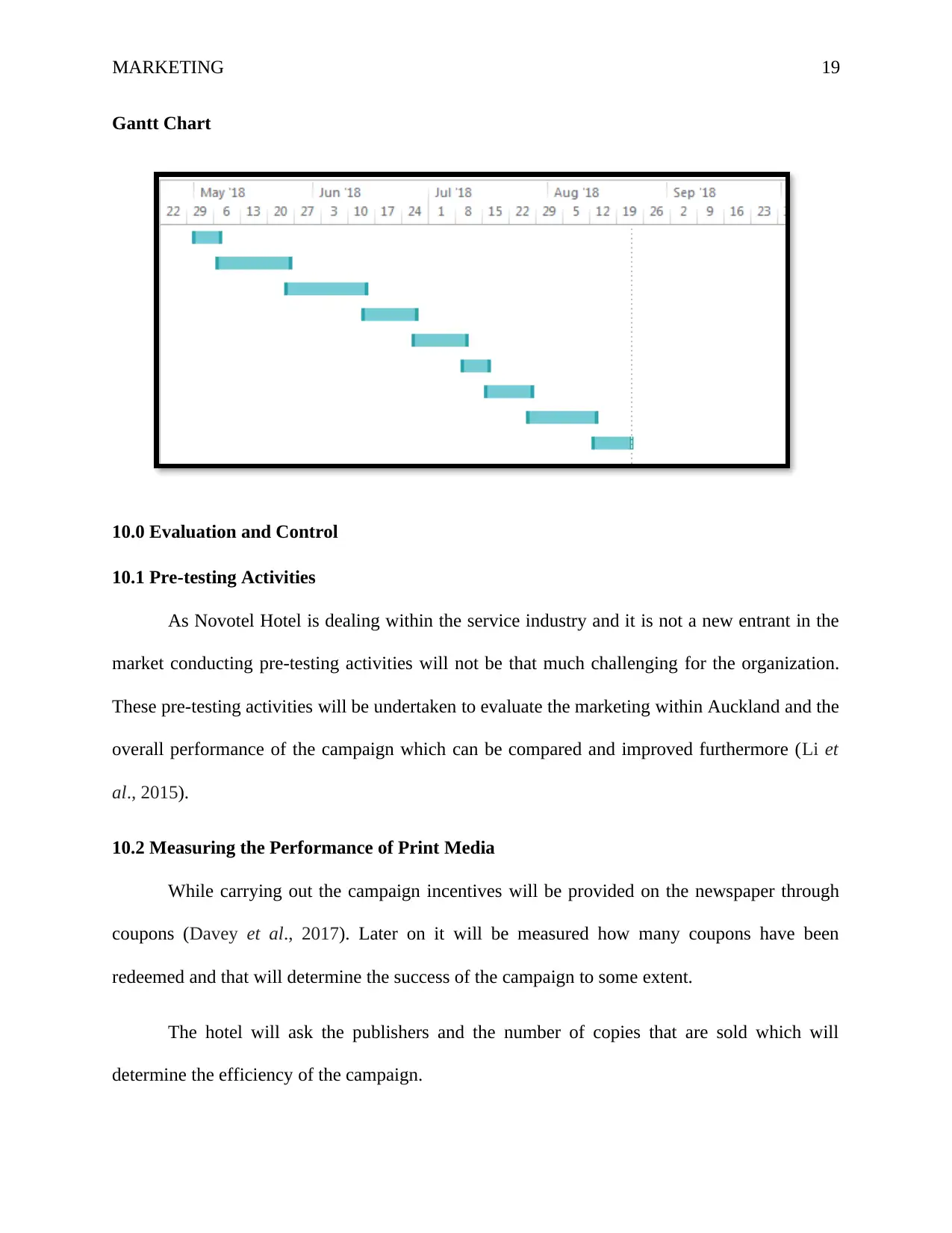
MARKETING 19
Gantt Chart
10.0 Evaluation and Control
10.1 Pre-testing Activities
As Novotel Hotel is dealing within the service industry and it is not a new entrant in the
market conducting pre-testing activities will not be that much challenging for the organization.
These pre-testing activities will be undertaken to evaluate the marketing within Auckland and the
overall performance of the campaign which can be compared and improved furthermore (Li et
al., 2015).
10.2 Measuring the Performance of Print Media
While carrying out the campaign incentives will be provided on the newspaper through
coupons (Davey et al., 2017). Later on it will be measured how many coupons have been
redeemed and that will determine the success of the campaign to some extent.
The hotel will ask the publishers and the number of copies that are sold which will
determine the efficiency of the campaign.
Gantt Chart
10.0 Evaluation and Control
10.1 Pre-testing Activities
As Novotel Hotel is dealing within the service industry and it is not a new entrant in the
market conducting pre-testing activities will not be that much challenging for the organization.
These pre-testing activities will be undertaken to evaluate the marketing within Auckland and the
overall performance of the campaign which can be compared and improved furthermore (Li et
al., 2015).
10.2 Measuring the Performance of Print Media
While carrying out the campaign incentives will be provided on the newspaper through
coupons (Davey et al., 2017). Later on it will be measured how many coupons have been
redeemed and that will determine the success of the campaign to some extent.
The hotel will ask the publishers and the number of copies that are sold which will
determine the efficiency of the campaign.
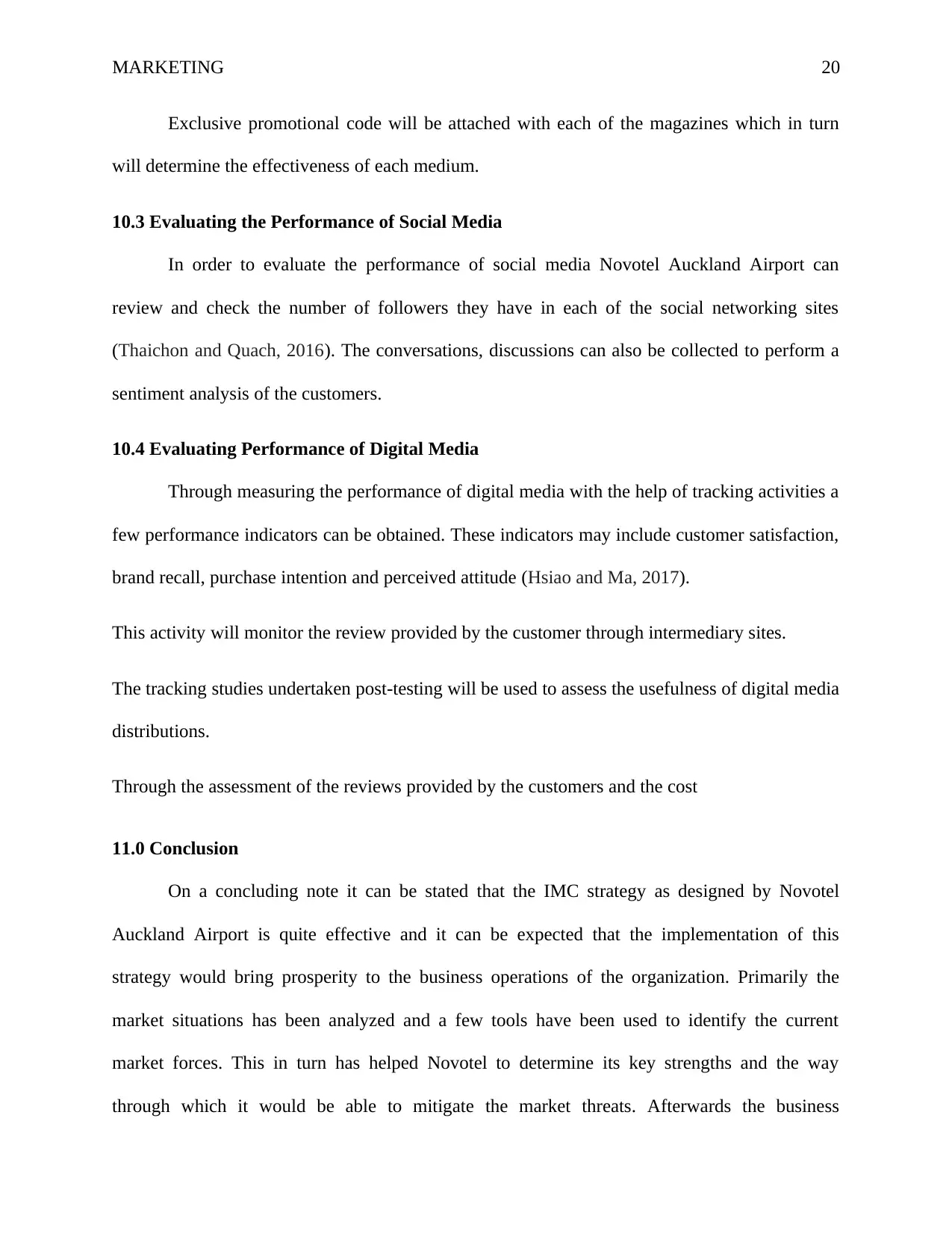
MARKETING 20
Exclusive promotional code will be attached with each of the magazines which in turn
will determine the effectiveness of each medium.
10.3 Evaluating the Performance of Social Media
In order to evaluate the performance of social media Novotel Auckland Airport can
review and check the number of followers they have in each of the social networking sites
(Thaichon and Quach, 2016). The conversations, discussions can also be collected to perform a
sentiment analysis of the customers.
10.4 Evaluating Performance of Digital Media
Through measuring the performance of digital media with the help of tracking activities a
few performance indicators can be obtained. These indicators may include customer satisfaction,
brand recall, purchase intention and perceived attitude (Hsiao and Ma, 2017).
This activity will monitor the review provided by the customer through intermediary sites.
The tracking studies undertaken post-testing will be used to assess the usefulness of digital media
distributions.
Through the assessment of the reviews provided by the customers and the cost
11.0 Conclusion
On a concluding note it can be stated that the IMC strategy as designed by Novotel
Auckland Airport is quite effective and it can be expected that the implementation of this
strategy would bring prosperity to the business operations of the organization. Primarily the
market situations has been analyzed and a few tools have been used to identify the current
market forces. This in turn has helped Novotel to determine its key strengths and the way
through which it would be able to mitigate the market threats. Afterwards the business
Exclusive promotional code will be attached with each of the magazines which in turn
will determine the effectiveness of each medium.
10.3 Evaluating the Performance of Social Media
In order to evaluate the performance of social media Novotel Auckland Airport can
review and check the number of followers they have in each of the social networking sites
(Thaichon and Quach, 2016). The conversations, discussions can also be collected to perform a
sentiment analysis of the customers.
10.4 Evaluating Performance of Digital Media
Through measuring the performance of digital media with the help of tracking activities a
few performance indicators can be obtained. These indicators may include customer satisfaction,
brand recall, purchase intention and perceived attitude (Hsiao and Ma, 2017).
This activity will monitor the review provided by the customer through intermediary sites.
The tracking studies undertaken post-testing will be used to assess the usefulness of digital media
distributions.
Through the assessment of the reviews provided by the customers and the cost
11.0 Conclusion
On a concluding note it can be stated that the IMC strategy as designed by Novotel
Auckland Airport is quite effective and it can be expected that the implementation of this
strategy would bring prosperity to the business operations of the organization. Primarily the
market situations has been analyzed and a few tools have been used to identify the current
market forces. This in turn has helped Novotel to determine its key strengths and the way
through which it would be able to mitigate the market threats. Afterwards the business
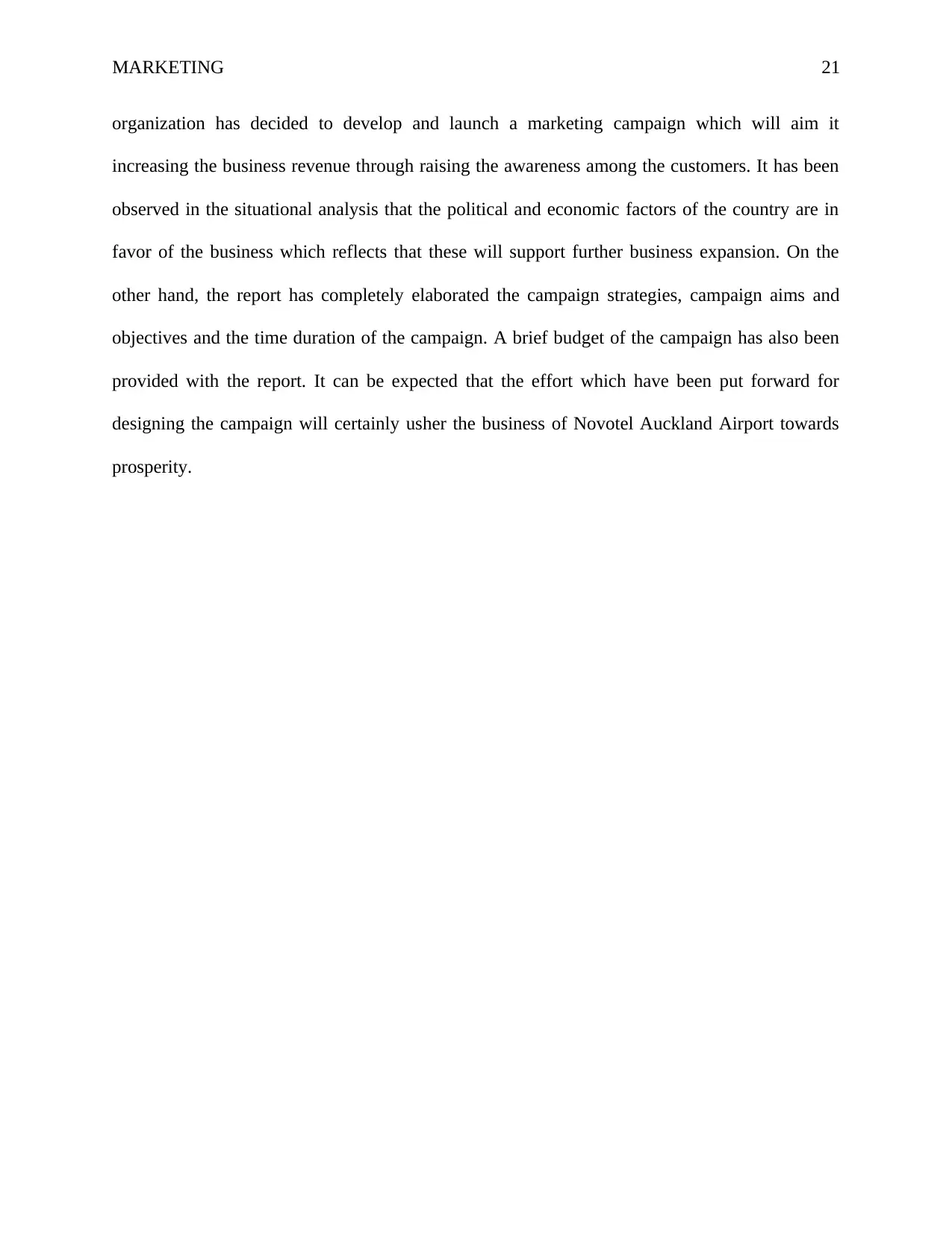
MARKETING 21
organization has decided to develop and launch a marketing campaign which will aim it
increasing the business revenue through raising the awareness among the customers. It has been
observed in the situational analysis that the political and economic factors of the country are in
favor of the business which reflects that these will support further business expansion. On the
other hand, the report has completely elaborated the campaign strategies, campaign aims and
objectives and the time duration of the campaign. A brief budget of the campaign has also been
provided with the report. It can be expected that the effort which have been put forward for
designing the campaign will certainly usher the business of Novotel Auckland Airport towards
prosperity.
organization has decided to develop and launch a marketing campaign which will aim it
increasing the business revenue through raising the awareness among the customers. It has been
observed in the situational analysis that the political and economic factors of the country are in
favor of the business which reflects that these will support further business expansion. On the
other hand, the report has completely elaborated the campaign strategies, campaign aims and
objectives and the time duration of the campaign. A brief budget of the campaign has also been
provided with the report. It can be expected that the effort which have been put forward for
designing the campaign will certainly usher the business of Novotel Auckland Airport towards
prosperity.
Secure Best Marks with AI Grader
Need help grading? Try our AI Grader for instant feedback on your assignments.

MARKETING 22
Reference List
Accorhotels.group. 2018. AccorHotels Group – Worldwide leader in Hospitality and services –
Feel Welcome. [online] Available at: http://www.accorhotels.group [Accessed 9 Apr. 2018].
Buhalis, D. and Mamalakis, E., 2015. Social media return on investment and performance
evaluation in the hotel industry context. In Information and Communication Technologies in
Tourism 2015 (pp. 241-253). Springer, Cham.
Clarke, A.E., Friese, C. and Washburn, R., 2016. Situational analysis in practice: Mapping
research with grounded theory. Routledge.
Damarjati, I.H., Kusumawati, A. and Mawardi, M.K., 2016. The influence of integrated
marketing communication (IMC) on brand equity and purchase decision (survey on indosat-M3
customers among members of unit Aktivitas band Universitas Brawijaya class of 2014). Jurnal
Administrasi Bisnis, 34(1), pp.29-37.
Davey, J., Alsemgeest, R., O’Reilly-Schwass, S., Davey, H. and FitzPatrick, M., 2017.
Visualizing intellectual capital using service-dominant logic: What are hotel companies
reporting?. International Journal of Contemporary Hospitality Management, 29(6), pp.1745-
1768.
De Pelsmacker, P., van Tilburg, S. and Holthof, C., 2018. Digital marketing strategies, online
reviews and hotel performance. International Journal of Hospitality Management, 72, pp.47-55.
Felix, R., Rauschnabel, P.A. and Hinsch, C., 2017. Elements of strategic social media marketing:
A holistic framework. Journal of Business Research, 70, pp.118-126.
Reference List
Accorhotels.group. 2018. AccorHotels Group – Worldwide leader in Hospitality and services –
Feel Welcome. [online] Available at: http://www.accorhotels.group [Accessed 9 Apr. 2018].
Buhalis, D. and Mamalakis, E., 2015. Social media return on investment and performance
evaluation in the hotel industry context. In Information and Communication Technologies in
Tourism 2015 (pp. 241-253). Springer, Cham.
Clarke, A.E., Friese, C. and Washburn, R., 2016. Situational analysis in practice: Mapping
research with grounded theory. Routledge.
Damarjati, I.H., Kusumawati, A. and Mawardi, M.K., 2016. The influence of integrated
marketing communication (IMC) on brand equity and purchase decision (survey on indosat-M3
customers among members of unit Aktivitas band Universitas Brawijaya class of 2014). Jurnal
Administrasi Bisnis, 34(1), pp.29-37.
Davey, J., Alsemgeest, R., O’Reilly-Schwass, S., Davey, H. and FitzPatrick, M., 2017.
Visualizing intellectual capital using service-dominant logic: What are hotel companies
reporting?. International Journal of Contemporary Hospitality Management, 29(6), pp.1745-
1768.
De Pelsmacker, P., van Tilburg, S. and Holthof, C., 2018. Digital marketing strategies, online
reviews and hotel performance. International Journal of Hospitality Management, 72, pp.47-55.
Felix, R., Rauschnabel, P.A. and Hinsch, C., 2017. Elements of strategic social media marketing:
A holistic framework. Journal of Business Research, 70, pp.118-126.
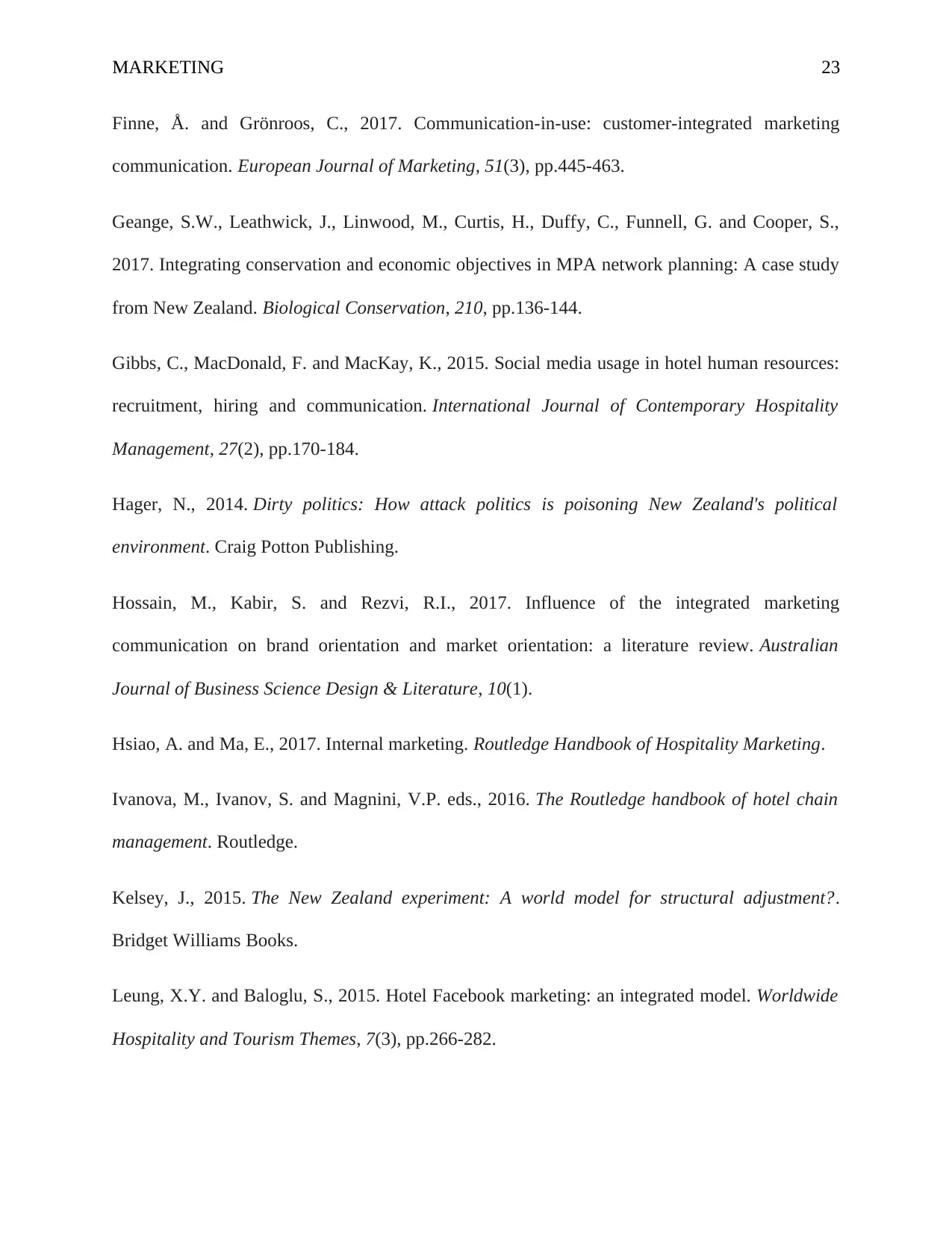
MARKETING 23
Finne, Å. and Grönroos, C., 2017. Communication-in-use: customer-integrated marketing
communication. European Journal of Marketing, 51(3), pp.445-463.
Geange, S.W., Leathwick, J., Linwood, M., Curtis, H., Duffy, C., Funnell, G. and Cooper, S.,
2017. Integrating conservation and economic objectives in MPA network planning: A case study
from New Zealand. Biological Conservation, 210, pp.136-144.
Gibbs, C., MacDonald, F. and MacKay, K., 2015. Social media usage in hotel human resources:
recruitment, hiring and communication. International Journal of Contemporary Hospitality
Management, 27(2), pp.170-184.
Hager, N., 2014. Dirty politics: How attack politics is poisoning New Zealand's political
environment. Craig Potton Publishing.
Hossain, M., Kabir, S. and Rezvi, R.I., 2017. Influence of the integrated marketing
communication on brand orientation and market orientation: a literature review. Australian
Journal of Business Science Design & Literature, 10(1).
Hsiao, A. and Ma, E., 2017. Internal marketing. Routledge Handbook of Hospitality Marketing.
Ivanova, M., Ivanov, S. and Magnini, V.P. eds., 2016. The Routledge handbook of hotel chain
management. Routledge.
Kelsey, J., 2015. The New Zealand experiment: A world model for structural adjustment?.
Bridget Williams Books.
Leung, X.Y. and Baloglu, S., 2015. Hotel Facebook marketing: an integrated model. Worldwide
Hospitality and Tourism Themes, 7(3), pp.266-282.
Finne, Å. and Grönroos, C., 2017. Communication-in-use: customer-integrated marketing
communication. European Journal of Marketing, 51(3), pp.445-463.
Geange, S.W., Leathwick, J., Linwood, M., Curtis, H., Duffy, C., Funnell, G. and Cooper, S.,
2017. Integrating conservation and economic objectives in MPA network planning: A case study
from New Zealand. Biological Conservation, 210, pp.136-144.
Gibbs, C., MacDonald, F. and MacKay, K., 2015. Social media usage in hotel human resources:
recruitment, hiring and communication. International Journal of Contemporary Hospitality
Management, 27(2), pp.170-184.
Hager, N., 2014. Dirty politics: How attack politics is poisoning New Zealand's political
environment. Craig Potton Publishing.
Hossain, M., Kabir, S. and Rezvi, R.I., 2017. Influence of the integrated marketing
communication on brand orientation and market orientation: a literature review. Australian
Journal of Business Science Design & Literature, 10(1).
Hsiao, A. and Ma, E., 2017. Internal marketing. Routledge Handbook of Hospitality Marketing.
Ivanova, M., Ivanov, S. and Magnini, V.P. eds., 2016. The Routledge handbook of hotel chain
management. Routledge.
Kelsey, J., 2015. The New Zealand experiment: A world model for structural adjustment?.
Bridget Williams Books.
Leung, X.Y. and Baloglu, S., 2015. Hotel Facebook marketing: an integrated model. Worldwide
Hospitality and Tourism Themes, 7(3), pp.266-282.
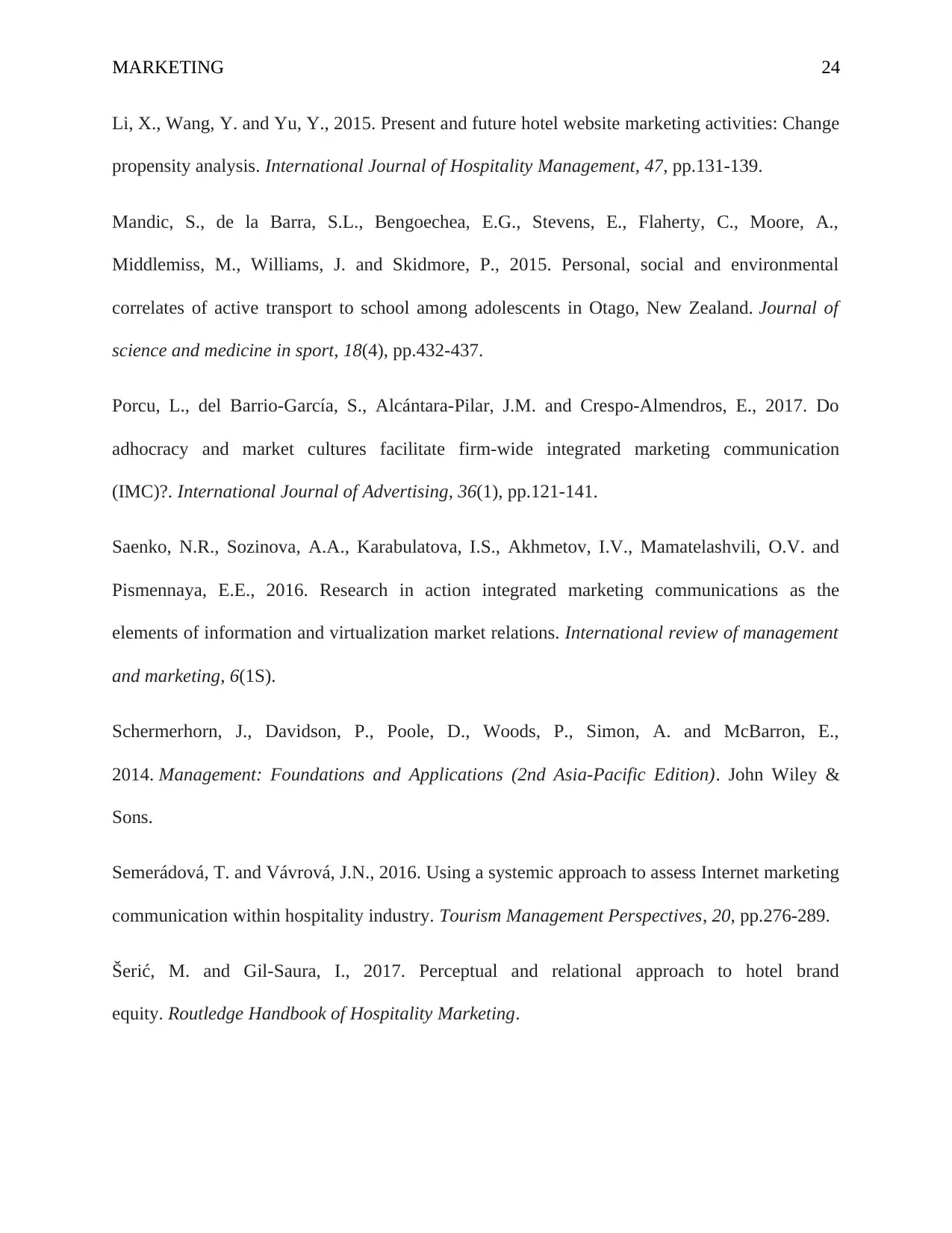
MARKETING 24
Li, X., Wang, Y. and Yu, Y., 2015. Present and future hotel website marketing activities: Change
propensity analysis. International Journal of Hospitality Management, 47, pp.131-139.
Mandic, S., de la Barra, S.L., Bengoechea, E.G., Stevens, E., Flaherty, C., Moore, A.,
Middlemiss, M., Williams, J. and Skidmore, P., 2015. Personal, social and environmental
correlates of active transport to school among adolescents in Otago, New Zealand. Journal of
science and medicine in sport, 18(4), pp.432-437.
Porcu, L., del Barrio-García, S., Alcántara-Pilar, J.M. and Crespo-Almendros, E., 2017. Do
adhocracy and market cultures facilitate firm-wide integrated marketing communication
(IMC)?. International Journal of Advertising, 36(1), pp.121-141.
Saenko, N.R., Sozinova, A.A., Karabulatova, I.S., Akhmetov, I.V., Mamatelashvili, O.V. and
Pismennaya, E.E., 2016. Research in action integrated marketing communications as the
elements of information and virtualization market relations. International review of management
and marketing, 6(1S).
Schermerhorn, J., Davidson, P., Poole, D., Woods, P., Simon, A. and McBarron, E.,
2014. Management: Foundations and Applications (2nd Asia-Pacific Edition). John Wiley &
Sons.
Semerádová, T. and Vávrová, J.N., 2016. Using a systemic approach to assess Internet marketing
communication within hospitality industry. Tourism Management Perspectives, 20, pp.276-289.
Šerić, M. and Gil-Saura, I., 2017. Perceptual and relational approach to hotel brand
equity. Routledge Handbook of Hospitality Marketing.
Li, X., Wang, Y. and Yu, Y., 2015. Present and future hotel website marketing activities: Change
propensity analysis. International Journal of Hospitality Management, 47, pp.131-139.
Mandic, S., de la Barra, S.L., Bengoechea, E.G., Stevens, E., Flaherty, C., Moore, A.,
Middlemiss, M., Williams, J. and Skidmore, P., 2015. Personal, social and environmental
correlates of active transport to school among adolescents in Otago, New Zealand. Journal of
science and medicine in sport, 18(4), pp.432-437.
Porcu, L., del Barrio-García, S., Alcántara-Pilar, J.M. and Crespo-Almendros, E., 2017. Do
adhocracy and market cultures facilitate firm-wide integrated marketing communication
(IMC)?. International Journal of Advertising, 36(1), pp.121-141.
Saenko, N.R., Sozinova, A.A., Karabulatova, I.S., Akhmetov, I.V., Mamatelashvili, O.V. and
Pismennaya, E.E., 2016. Research in action integrated marketing communications as the
elements of information and virtualization market relations. International review of management
and marketing, 6(1S).
Schermerhorn, J., Davidson, P., Poole, D., Woods, P., Simon, A. and McBarron, E.,
2014. Management: Foundations and Applications (2nd Asia-Pacific Edition). John Wiley &
Sons.
Semerádová, T. and Vávrová, J.N., 2016. Using a systemic approach to assess Internet marketing
communication within hospitality industry. Tourism Management Perspectives, 20, pp.276-289.
Šerić, M. and Gil-Saura, I., 2017. Perceptual and relational approach to hotel brand
equity. Routledge Handbook of Hospitality Marketing.
Paraphrase This Document
Need a fresh take? Get an instant paraphrase of this document with our AI Paraphraser
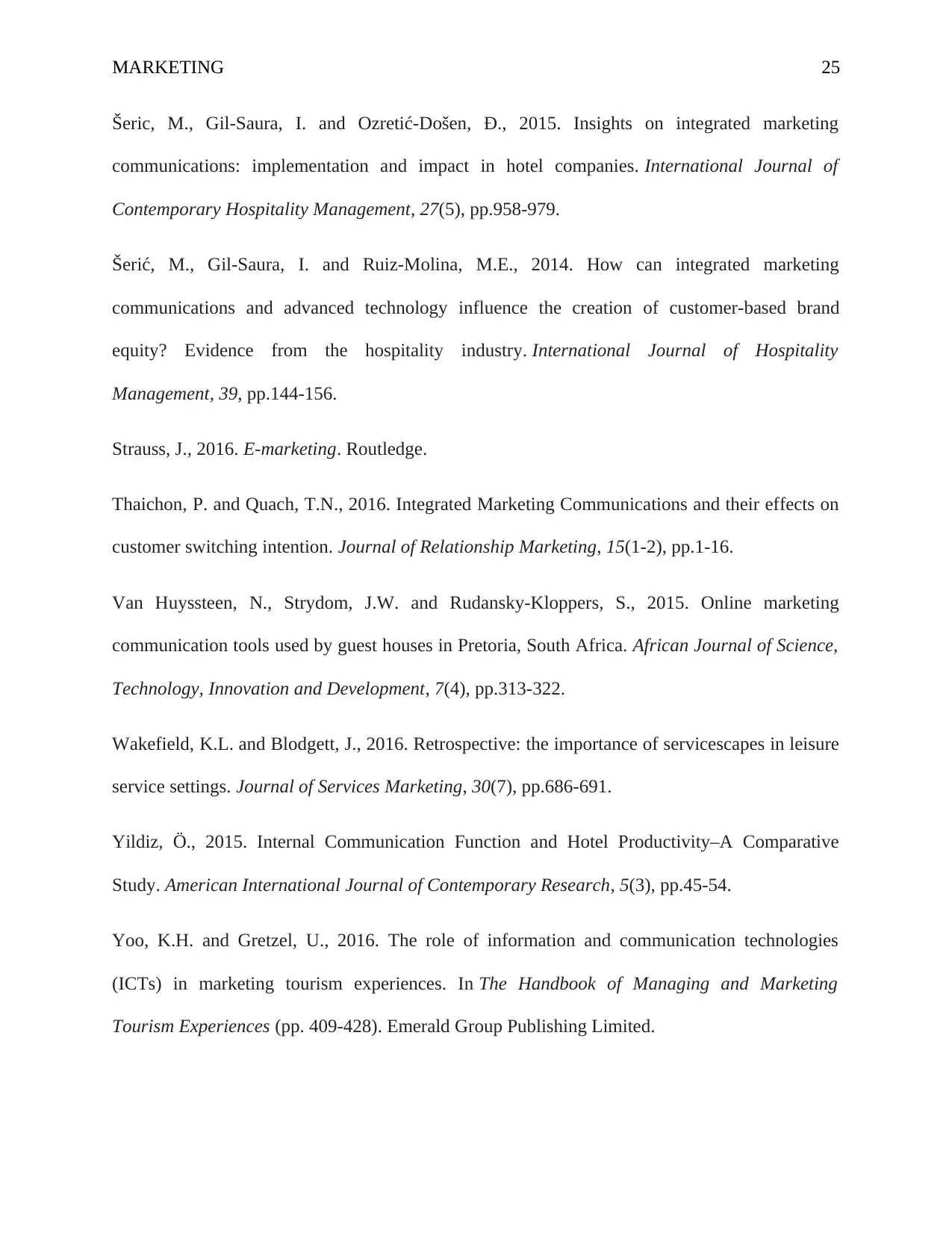
MARKETING 25
Šeric, M., Gil-Saura, I. and Ozretić-Došen, Đ., 2015. Insights on integrated marketing
communications: implementation and impact in hotel companies. International Journal of
Contemporary Hospitality Management, 27(5), pp.958-979.
Šerić, M., Gil-Saura, I. and Ruiz-Molina, M.E., 2014. How can integrated marketing
communications and advanced technology influence the creation of customer-based brand
equity? Evidence from the hospitality industry. International Journal of Hospitality
Management, 39, pp.144-156.
Strauss, J., 2016. E-marketing. Routledge.
Thaichon, P. and Quach, T.N., 2016. Integrated Marketing Communications and their effects on
customer switching intention. Journal of Relationship Marketing, 15(1-2), pp.1-16.
Van Huyssteen, N., Strydom, J.W. and Rudansky-Kloppers, S., 2015. Online marketing
communication tools used by guest houses in Pretoria, South Africa. African Journal of Science,
Technology, Innovation and Development, 7(4), pp.313-322.
Wakefield, K.L. and Blodgett, J., 2016. Retrospective: the importance of servicescapes in leisure
service settings. Journal of Services Marketing, 30(7), pp.686-691.
Yildiz, Ö., 2015. Internal Communication Function and Hotel Productivity–A Comparative
Study. American International Journal of Contemporary Research, 5(3), pp.45-54.
Yoo, K.H. and Gretzel, U., 2016. The role of information and communication technologies
(ICTs) in marketing tourism experiences. In The Handbook of Managing and Marketing
Tourism Experiences (pp. 409-428). Emerald Group Publishing Limited.
Šeric, M., Gil-Saura, I. and Ozretić-Došen, Đ., 2015. Insights on integrated marketing
communications: implementation and impact in hotel companies. International Journal of
Contemporary Hospitality Management, 27(5), pp.958-979.
Šerić, M., Gil-Saura, I. and Ruiz-Molina, M.E., 2014. How can integrated marketing
communications and advanced technology influence the creation of customer-based brand
equity? Evidence from the hospitality industry. International Journal of Hospitality
Management, 39, pp.144-156.
Strauss, J., 2016. E-marketing. Routledge.
Thaichon, P. and Quach, T.N., 2016. Integrated Marketing Communications and their effects on
customer switching intention. Journal of Relationship Marketing, 15(1-2), pp.1-16.
Van Huyssteen, N., Strydom, J.W. and Rudansky-Kloppers, S., 2015. Online marketing
communication tools used by guest houses in Pretoria, South Africa. African Journal of Science,
Technology, Innovation and Development, 7(4), pp.313-322.
Wakefield, K.L. and Blodgett, J., 2016. Retrospective: the importance of servicescapes in leisure
service settings. Journal of Services Marketing, 30(7), pp.686-691.
Yildiz, Ö., 2015. Internal Communication Function and Hotel Productivity–A Comparative
Study. American International Journal of Contemporary Research, 5(3), pp.45-54.
Yoo, K.H. and Gretzel, U., 2016. The role of information and communication technologies
(ICTs) in marketing tourism experiences. In The Handbook of Managing and Marketing
Tourism Experiences (pp. 409-428). Emerald Group Publishing Limited.
1 out of 26
Your All-in-One AI-Powered Toolkit for Academic Success.
+13062052269
info@desklib.com
Available 24*7 on WhatsApp / Email
![[object Object]](/_next/static/media/star-bottom.7253800d.svg)
Unlock your academic potential
© 2024 | Zucol Services PVT LTD | All rights reserved.





